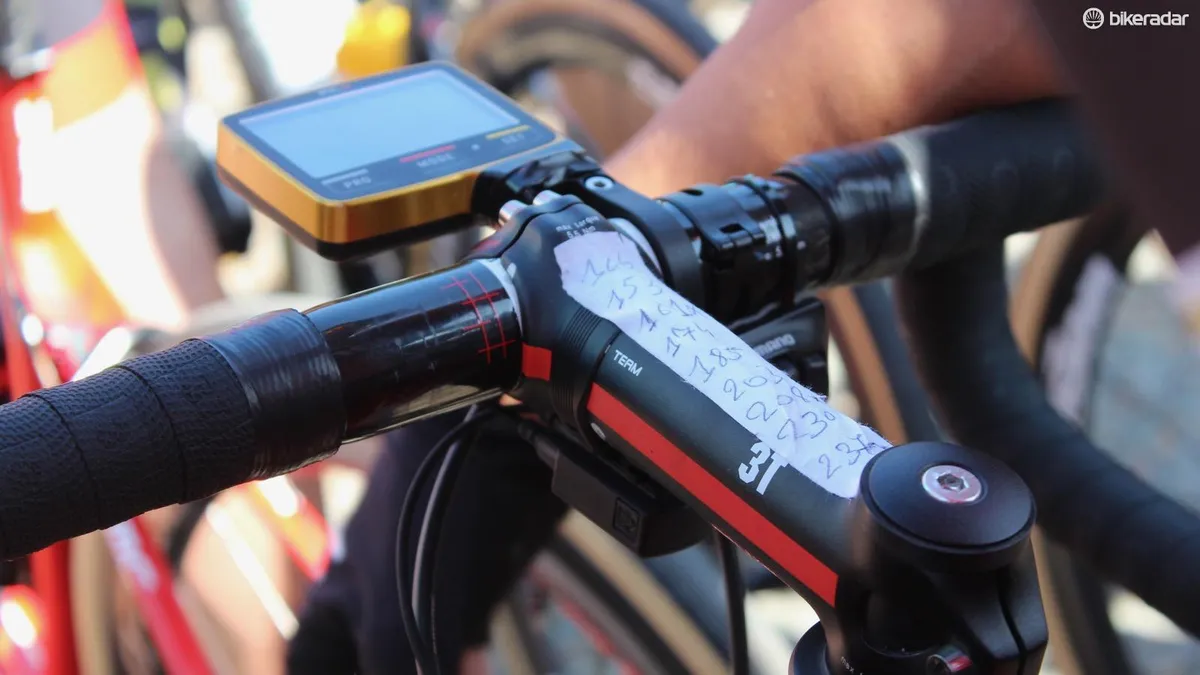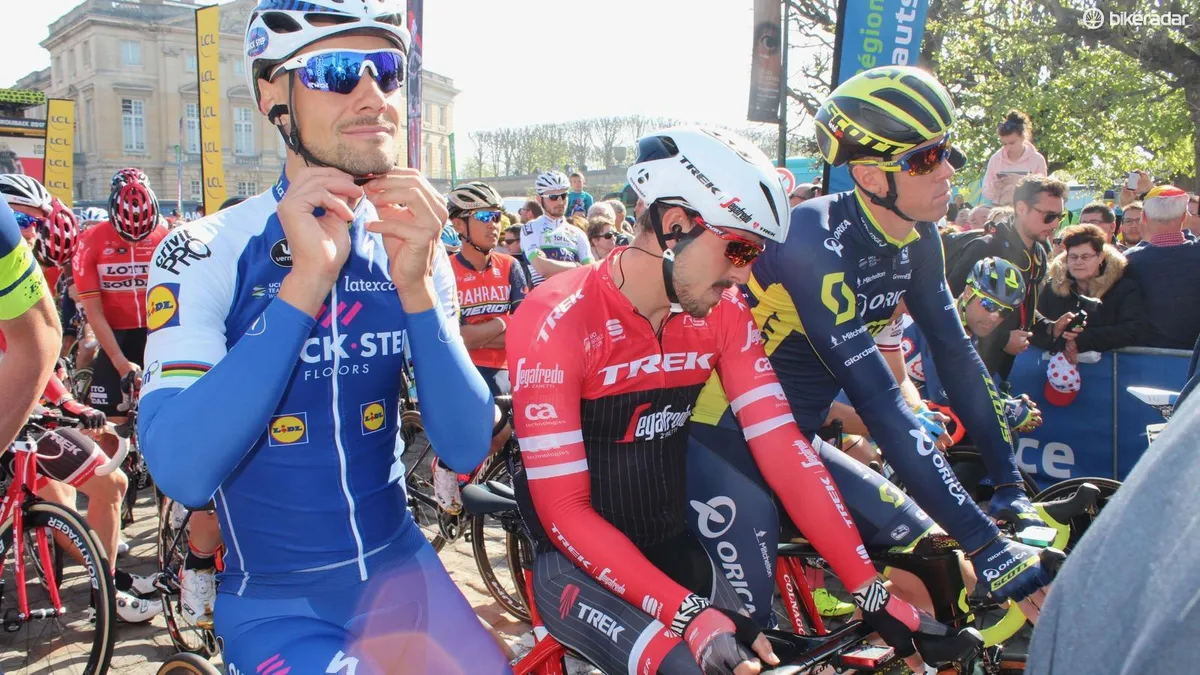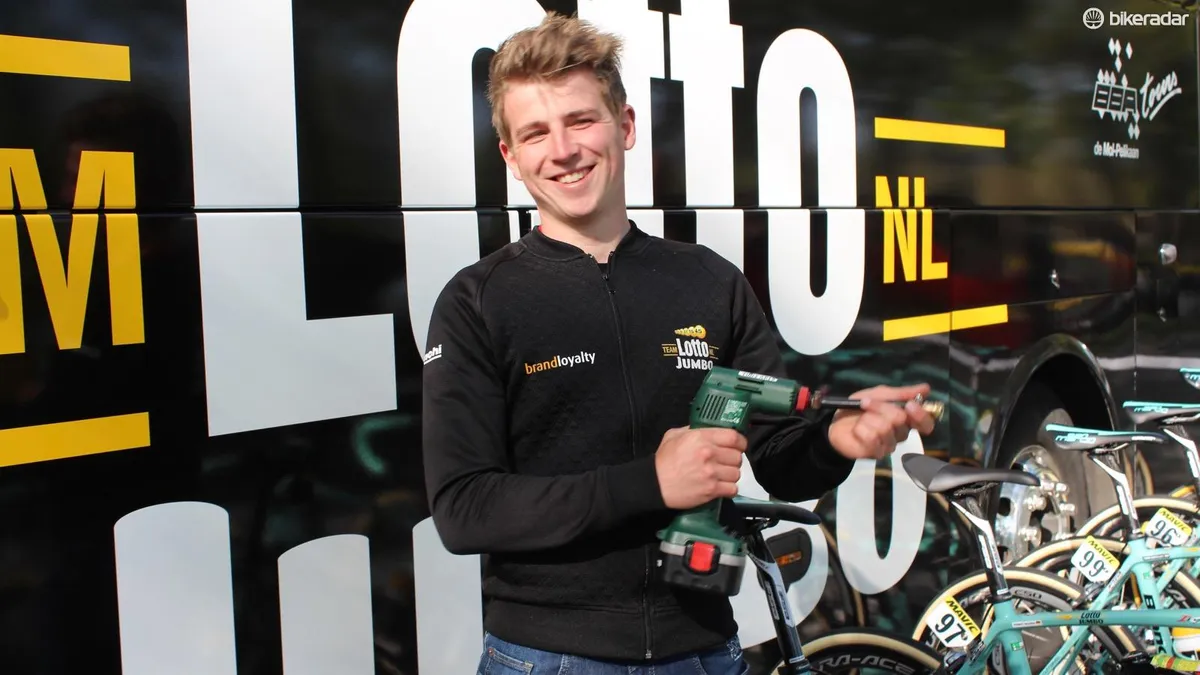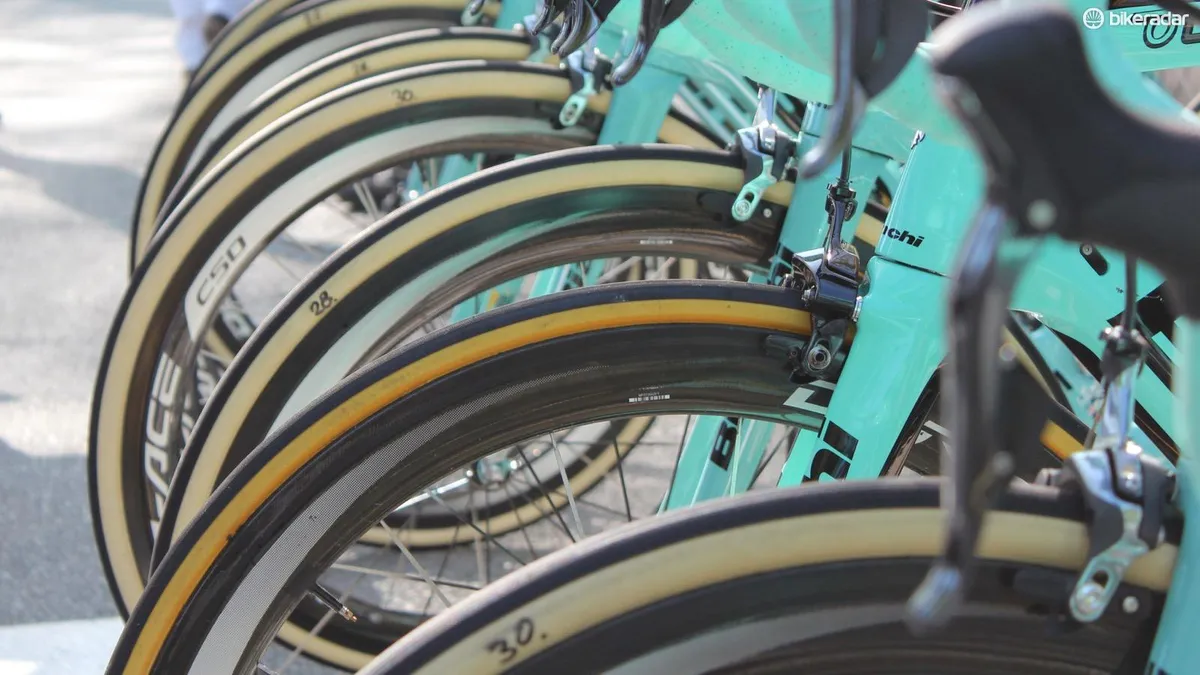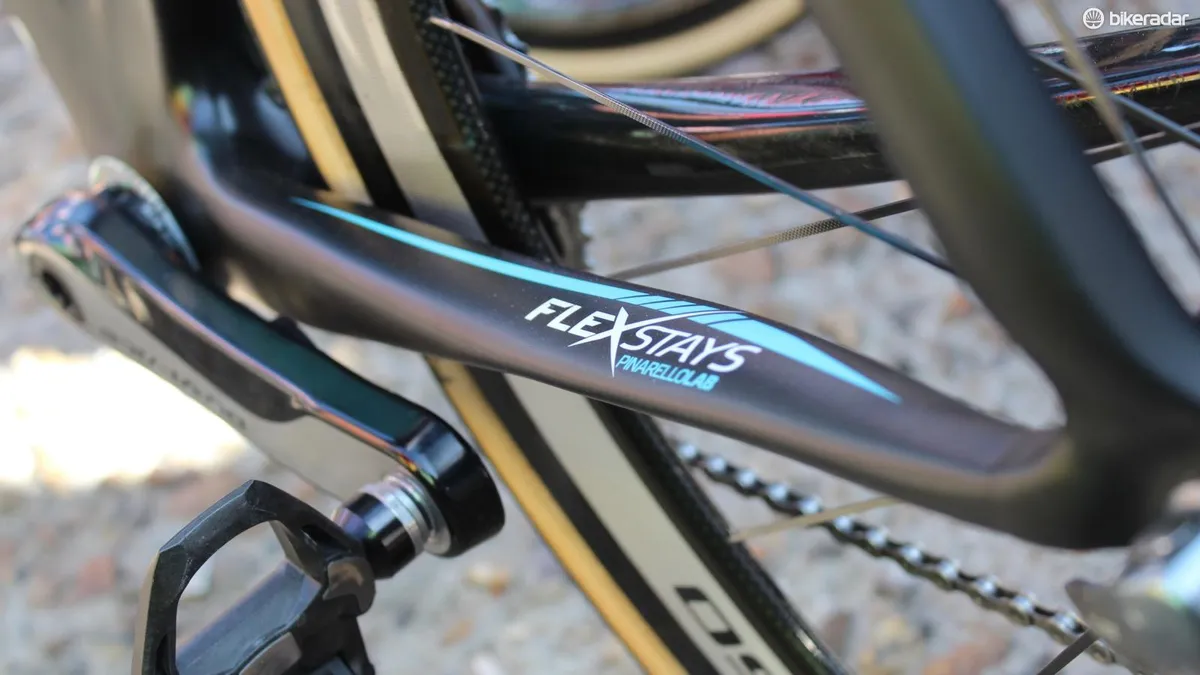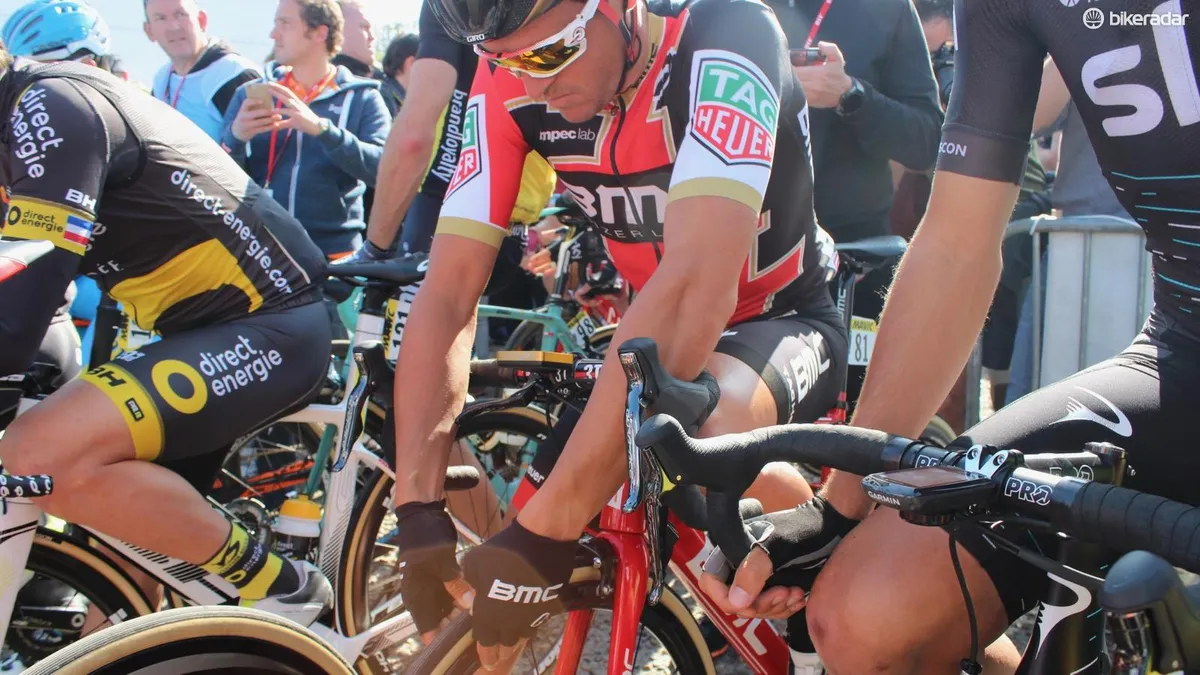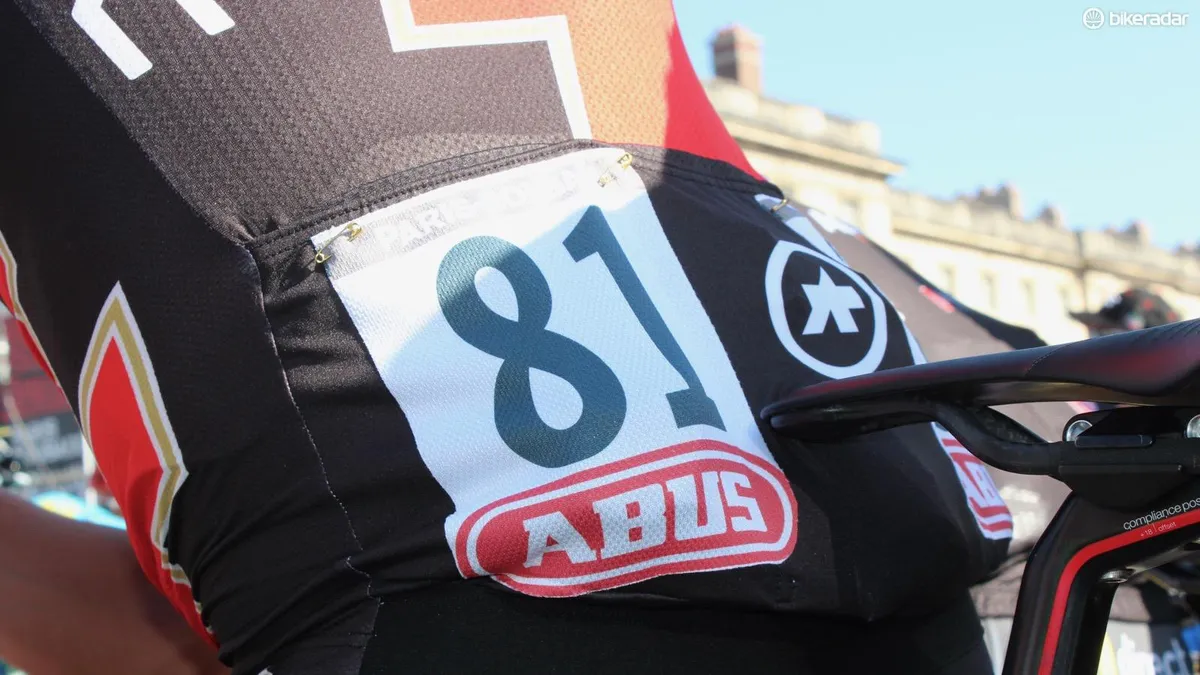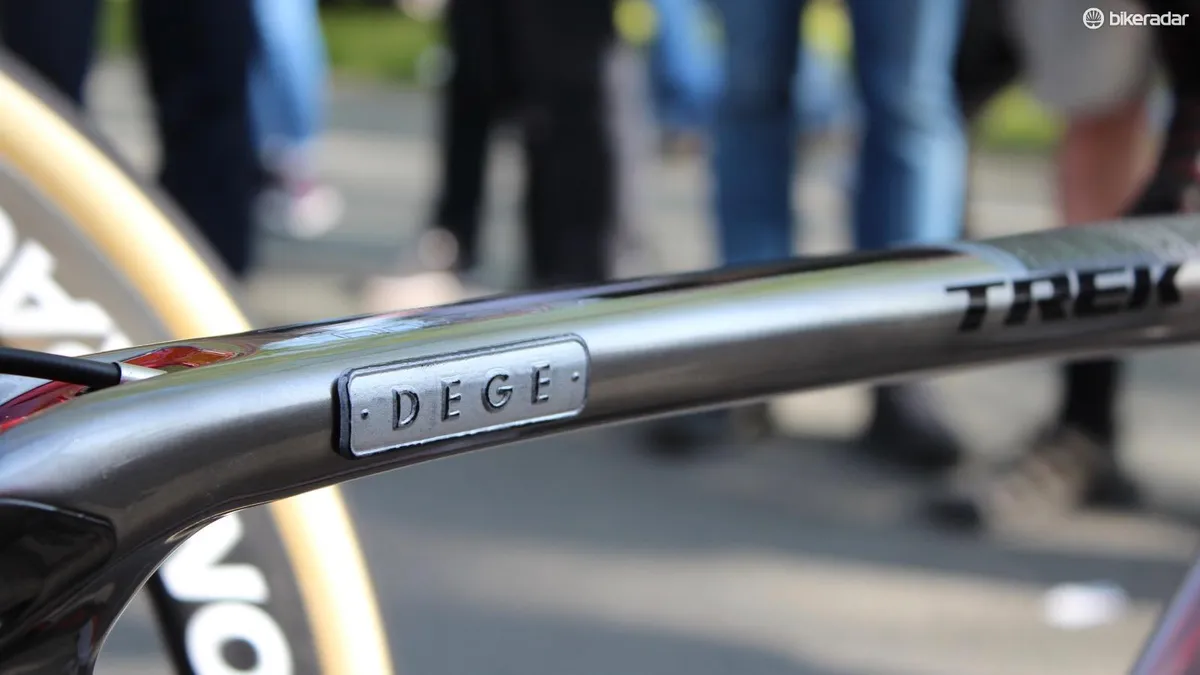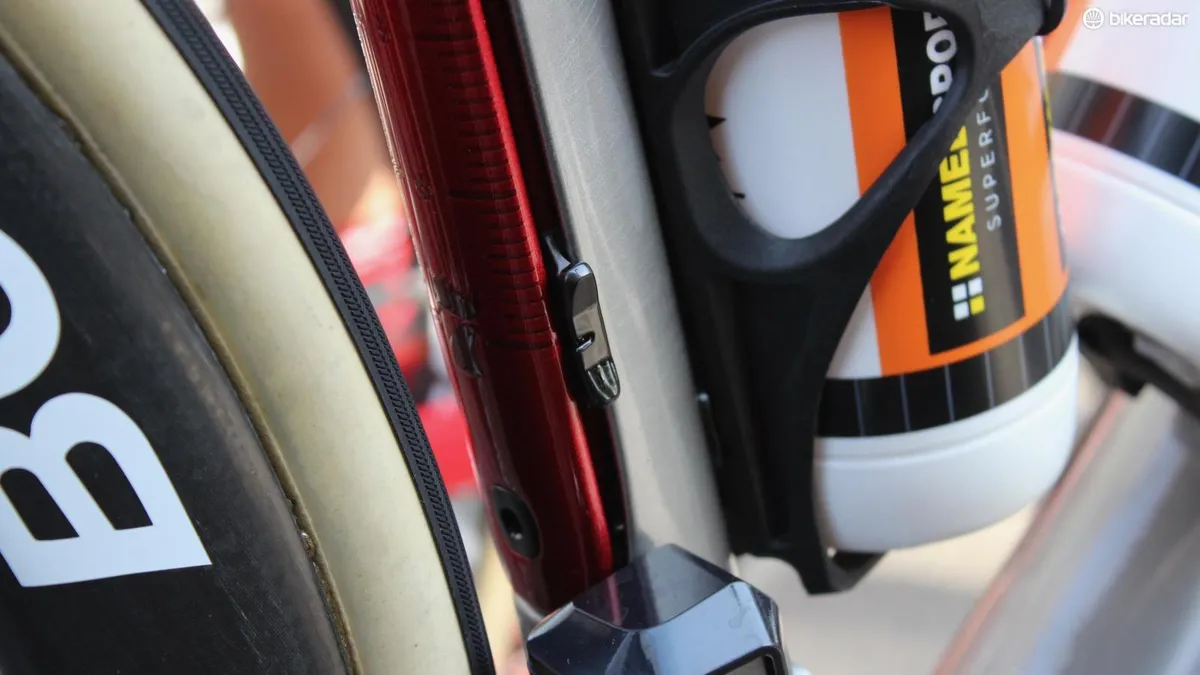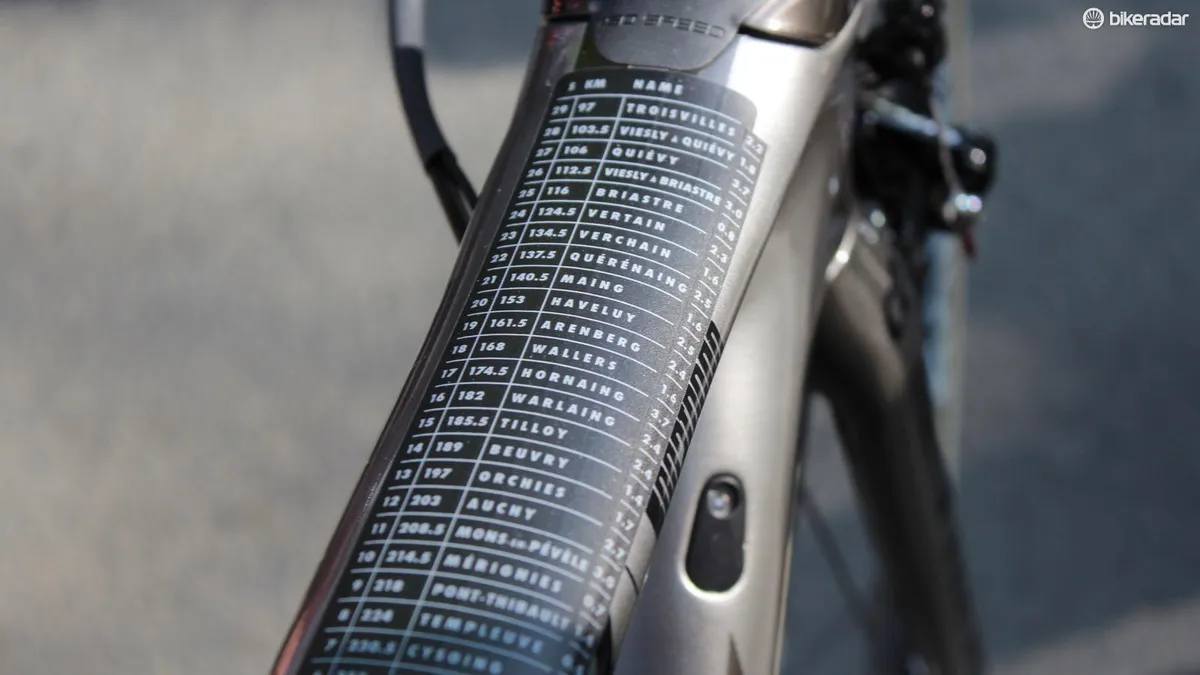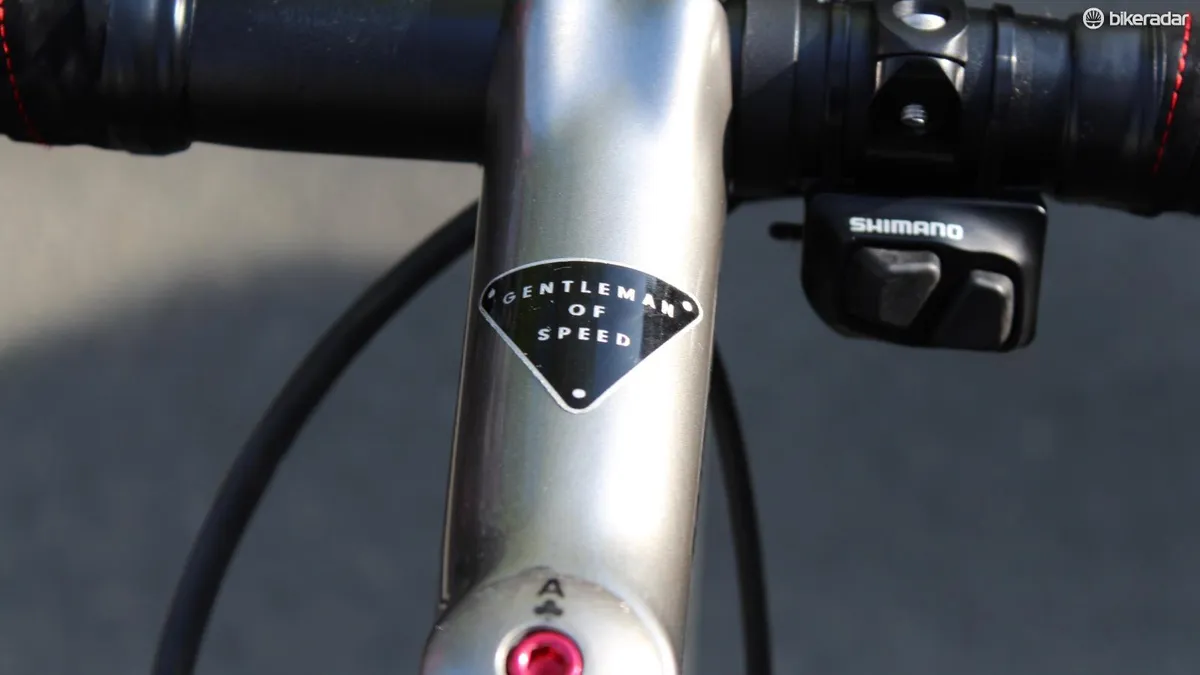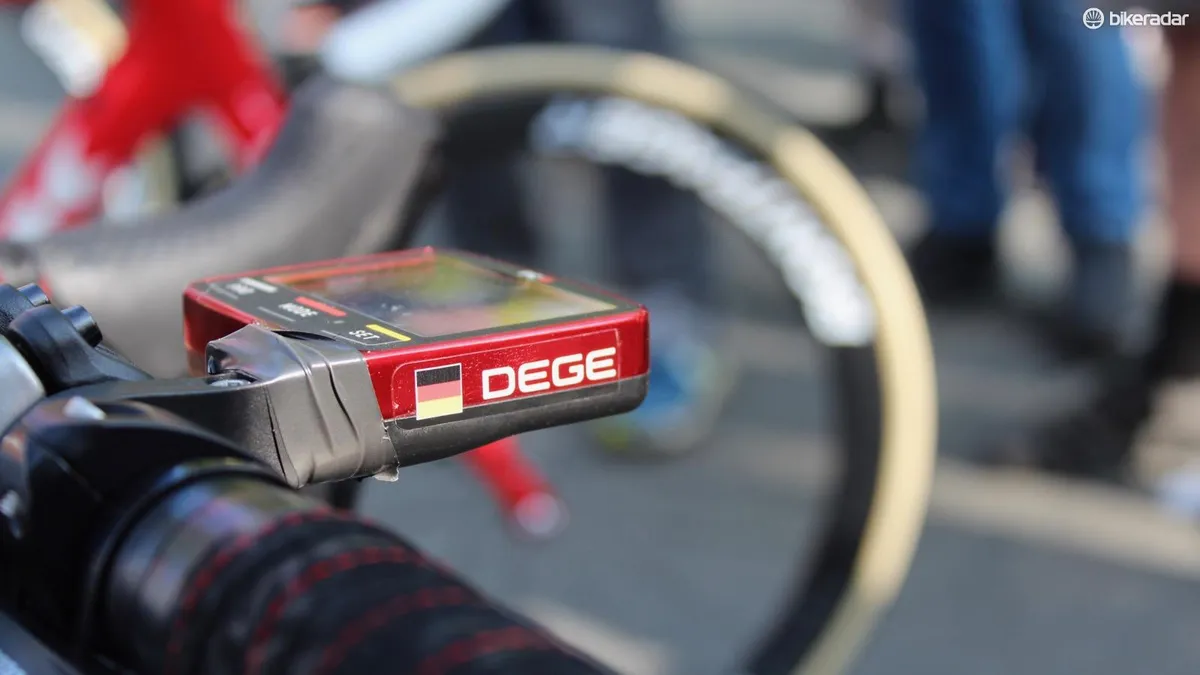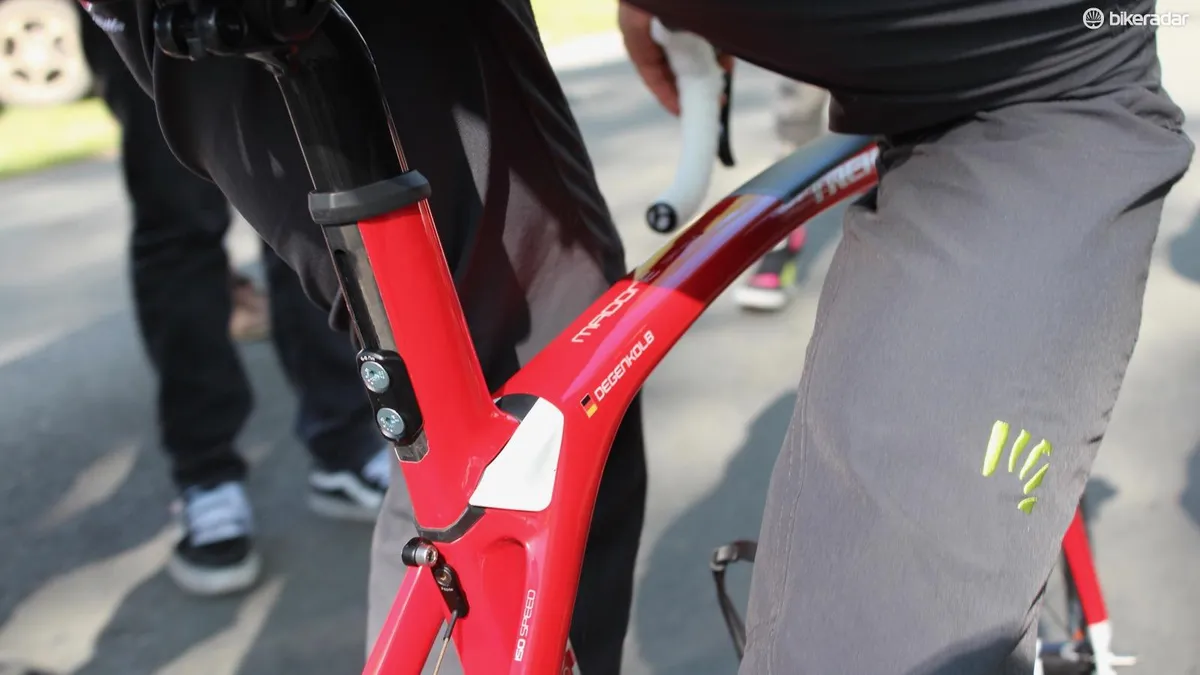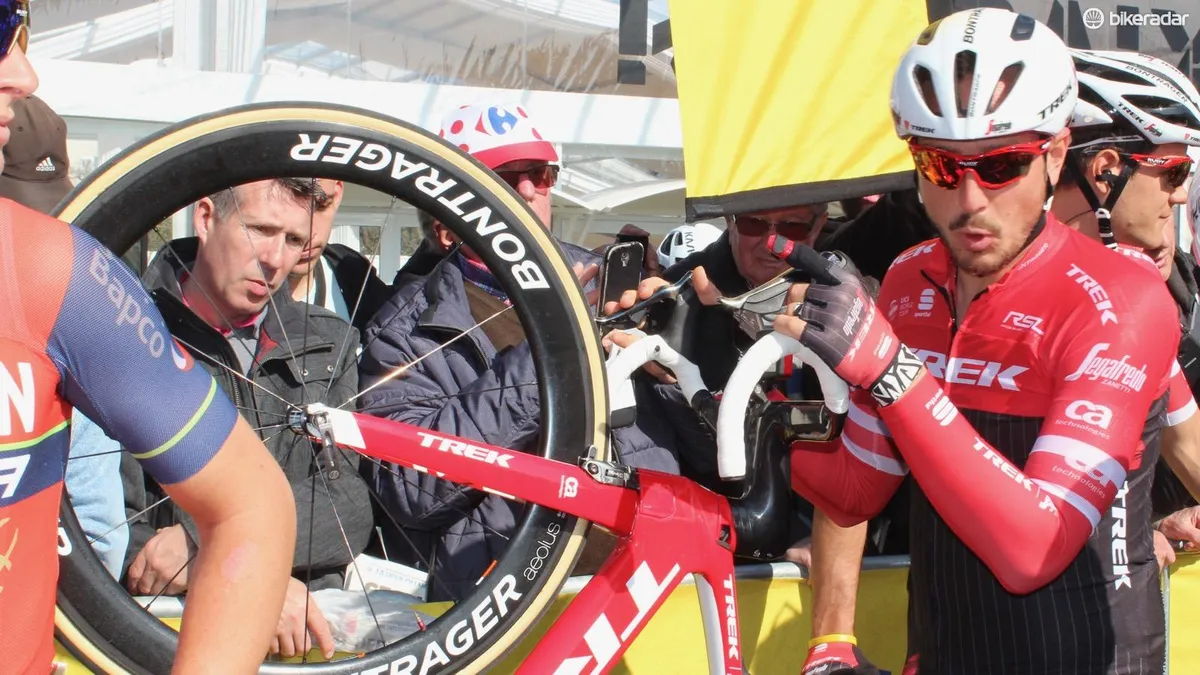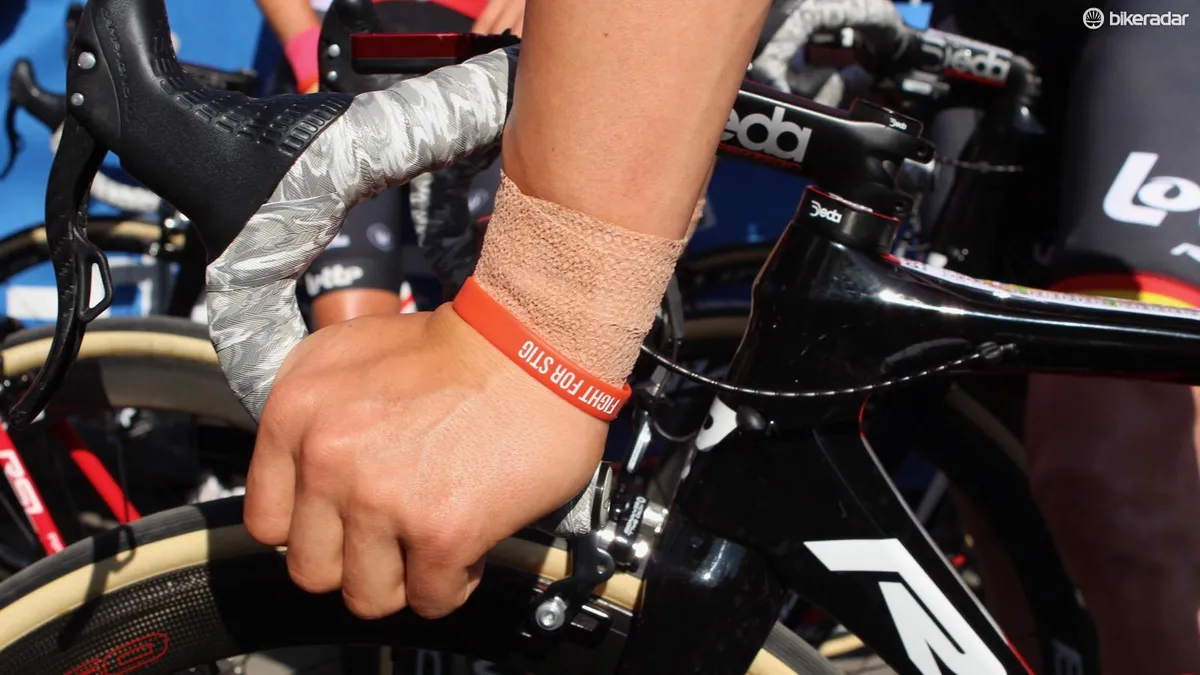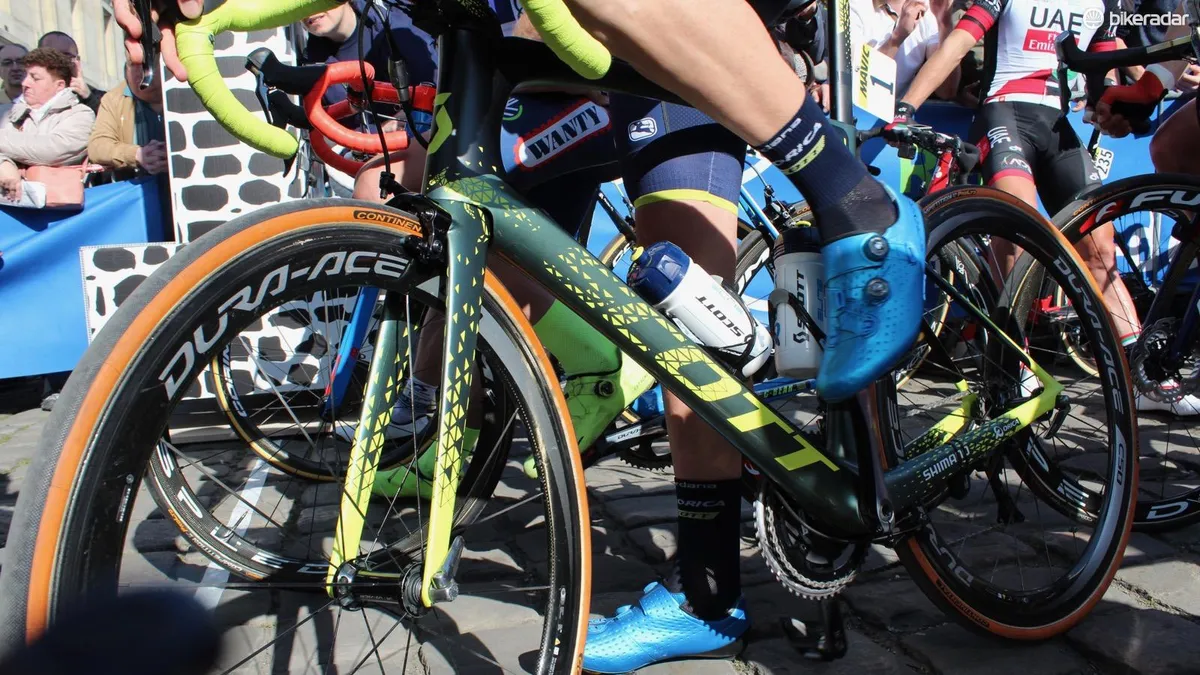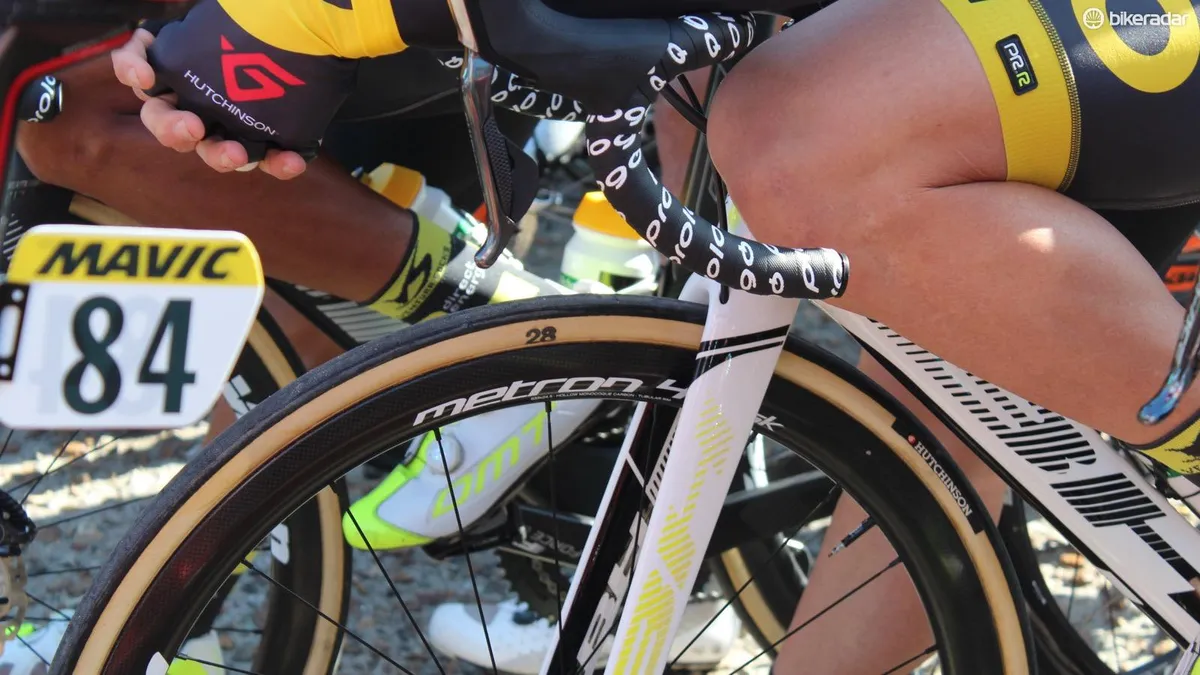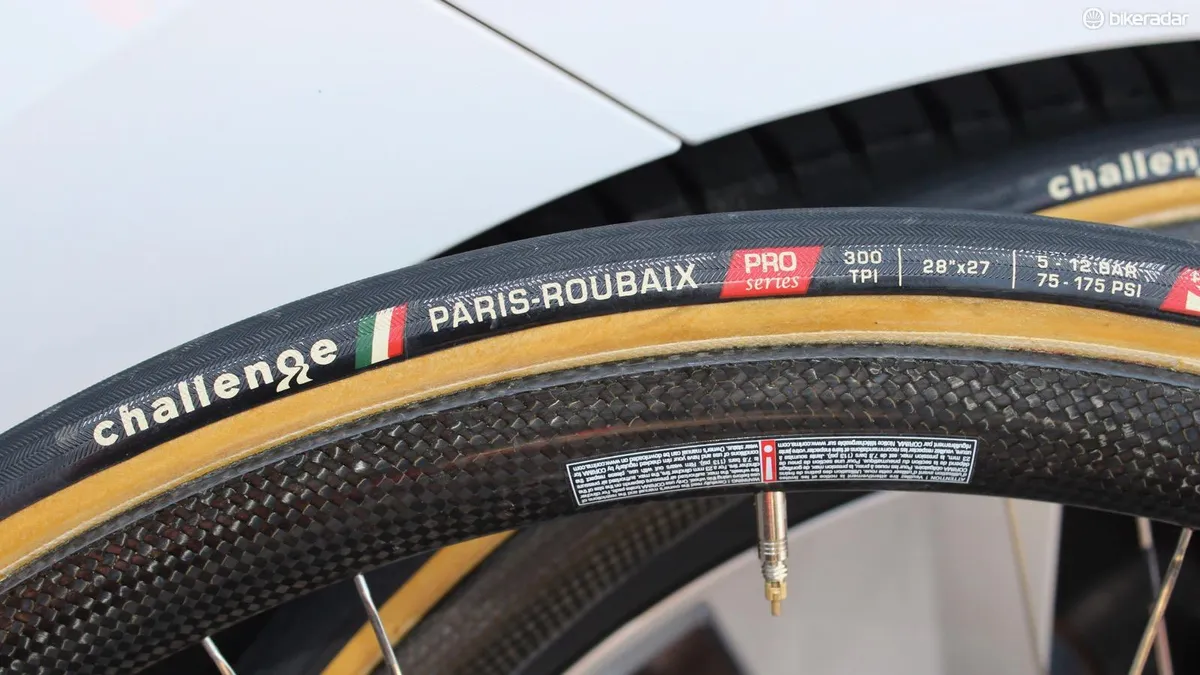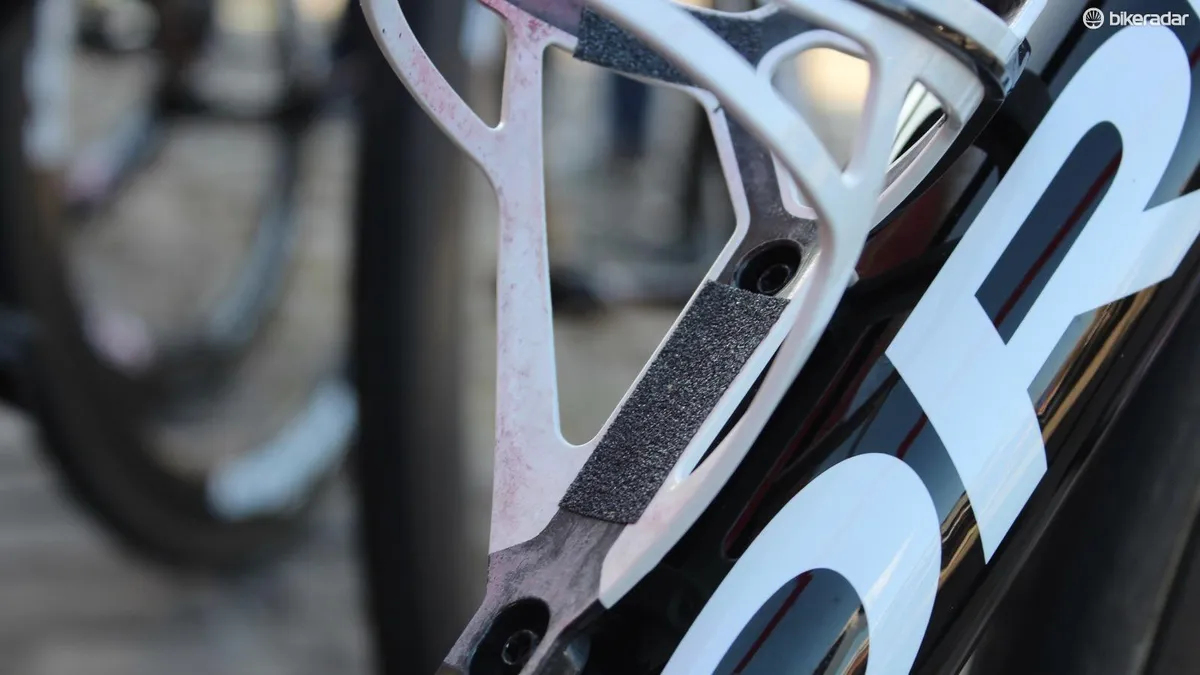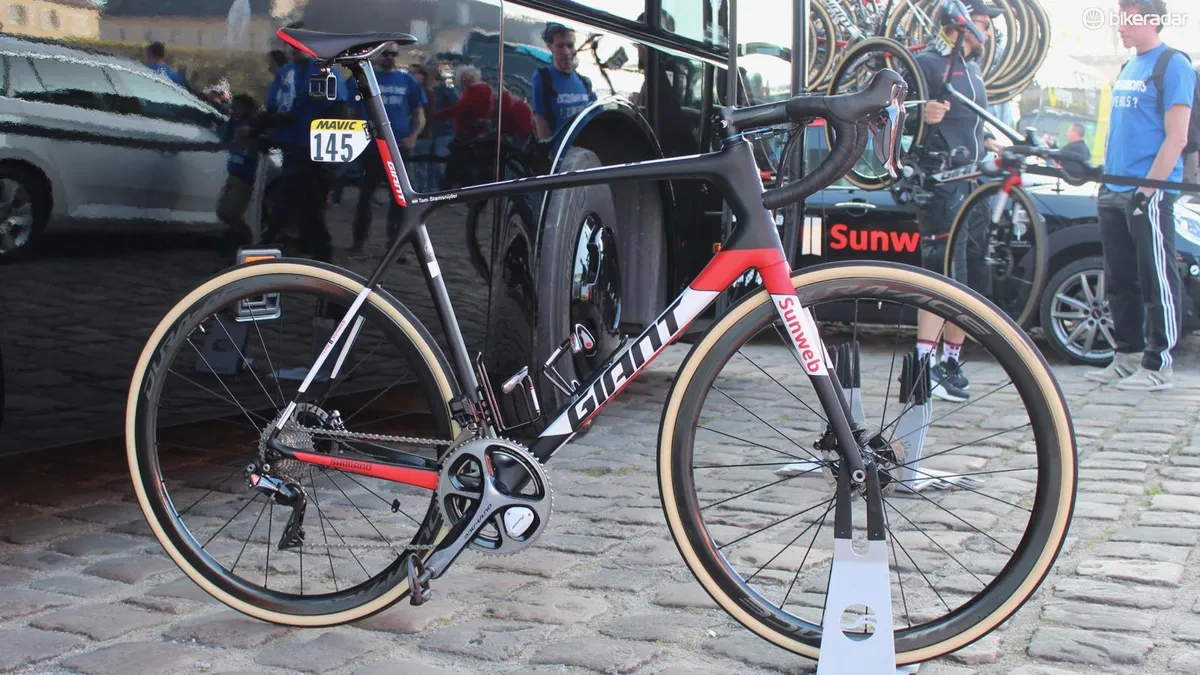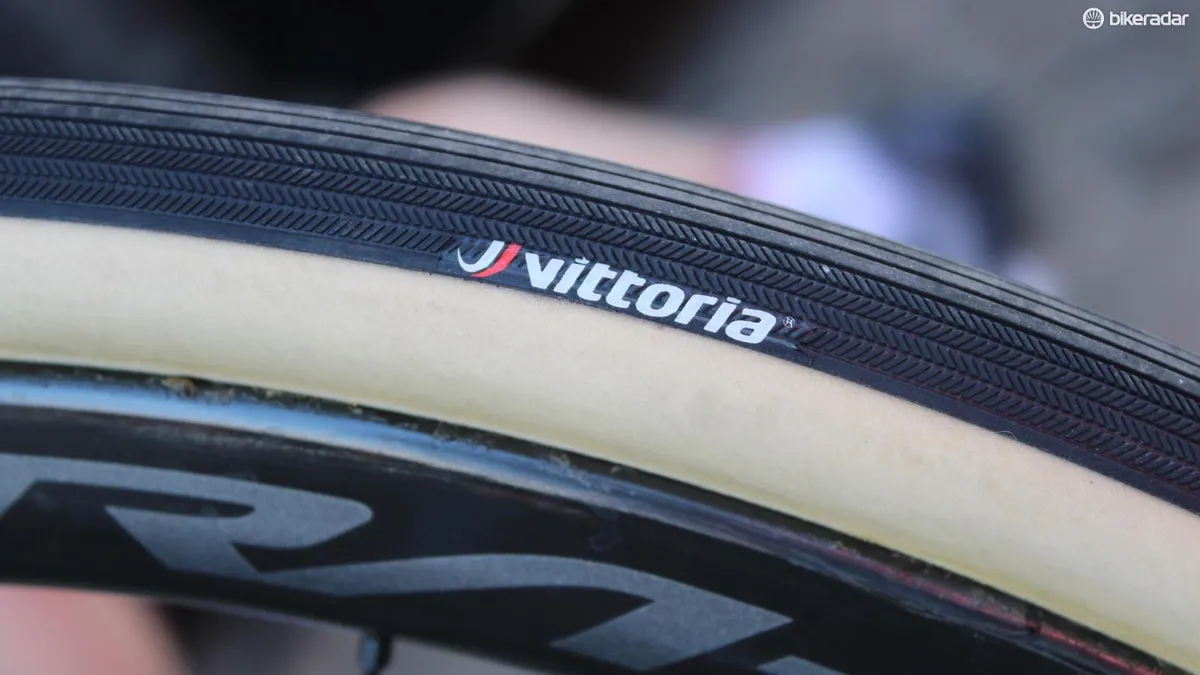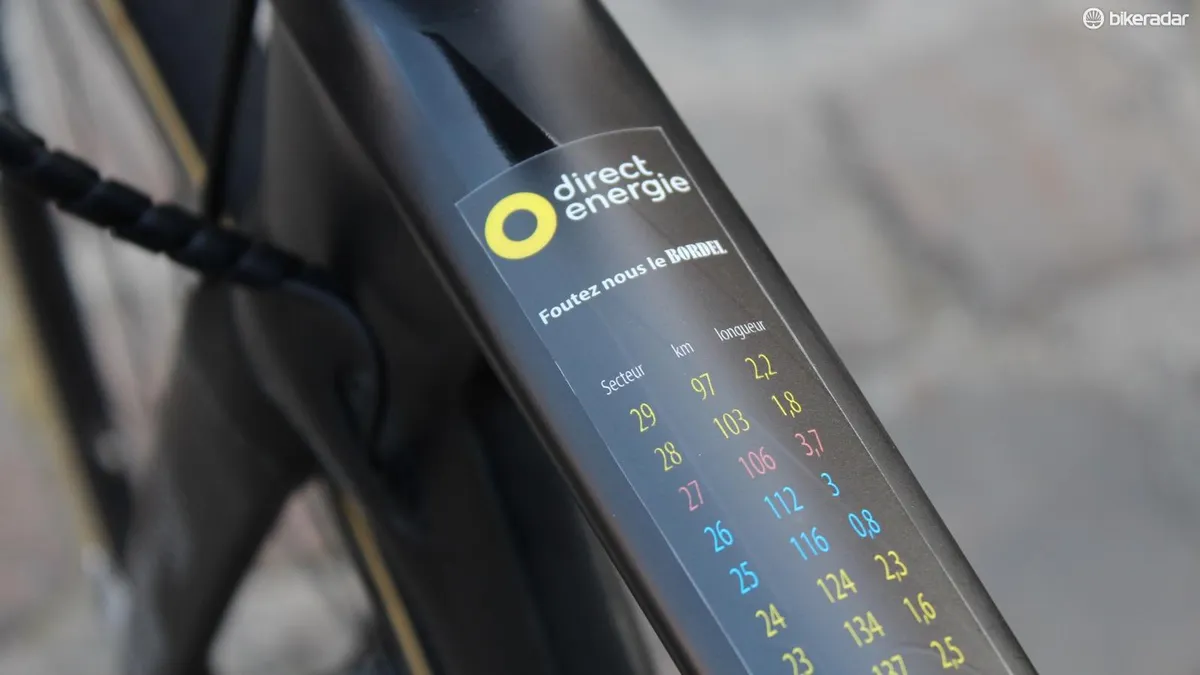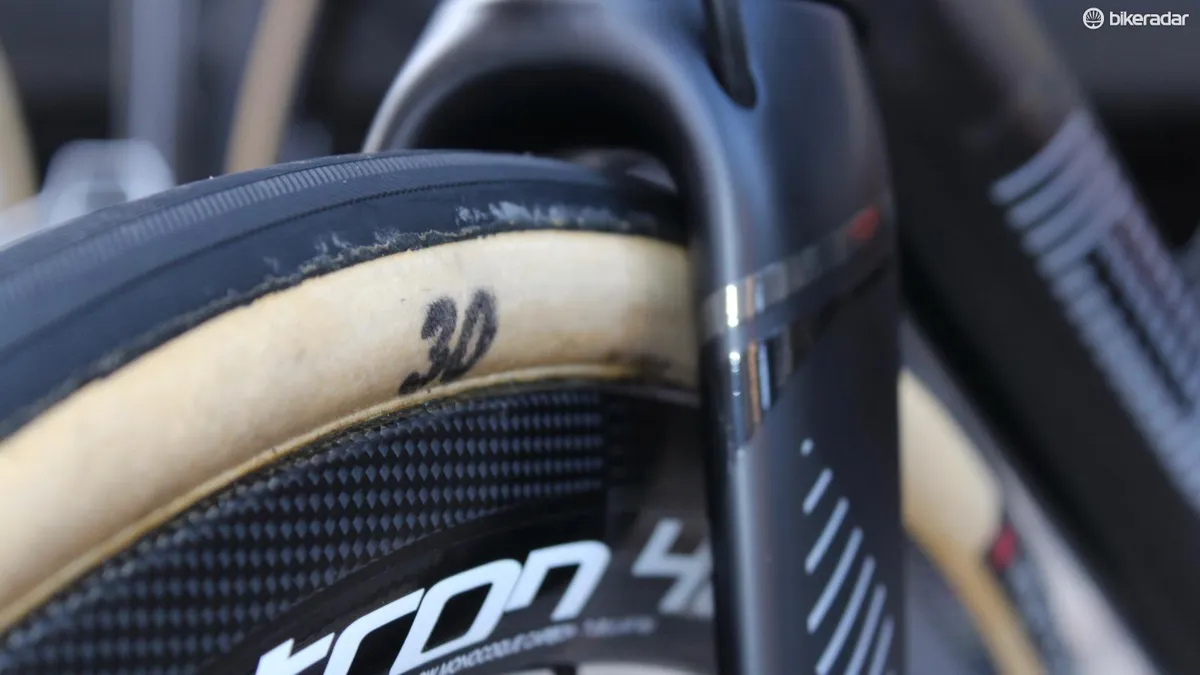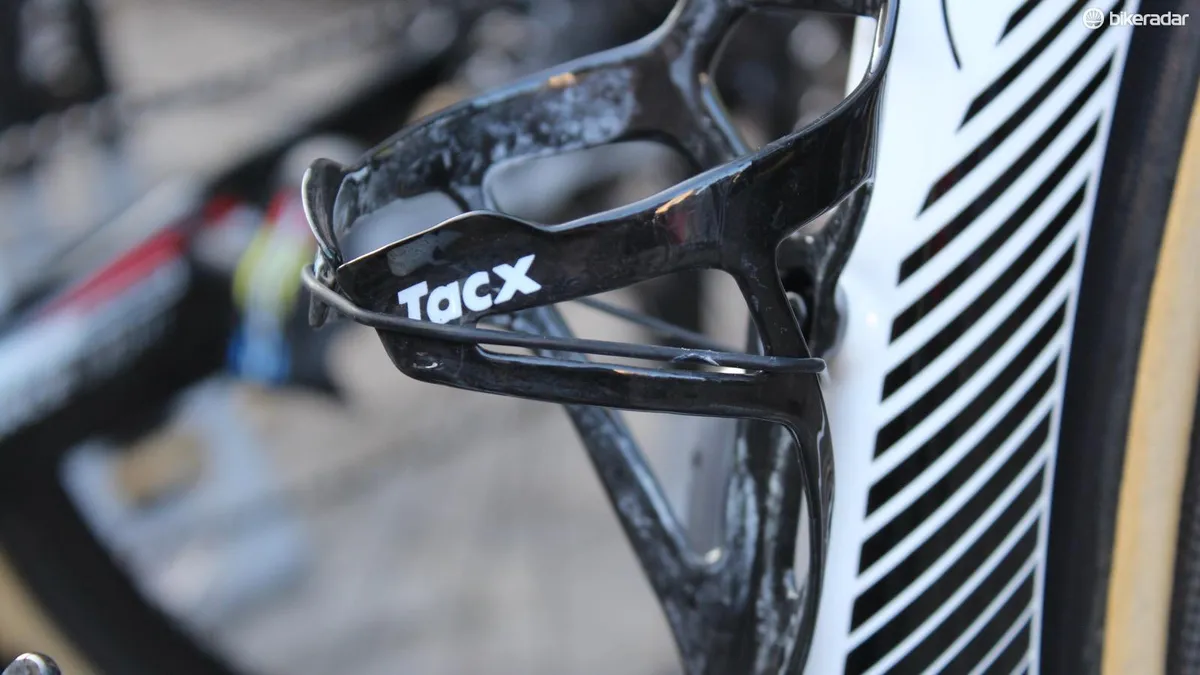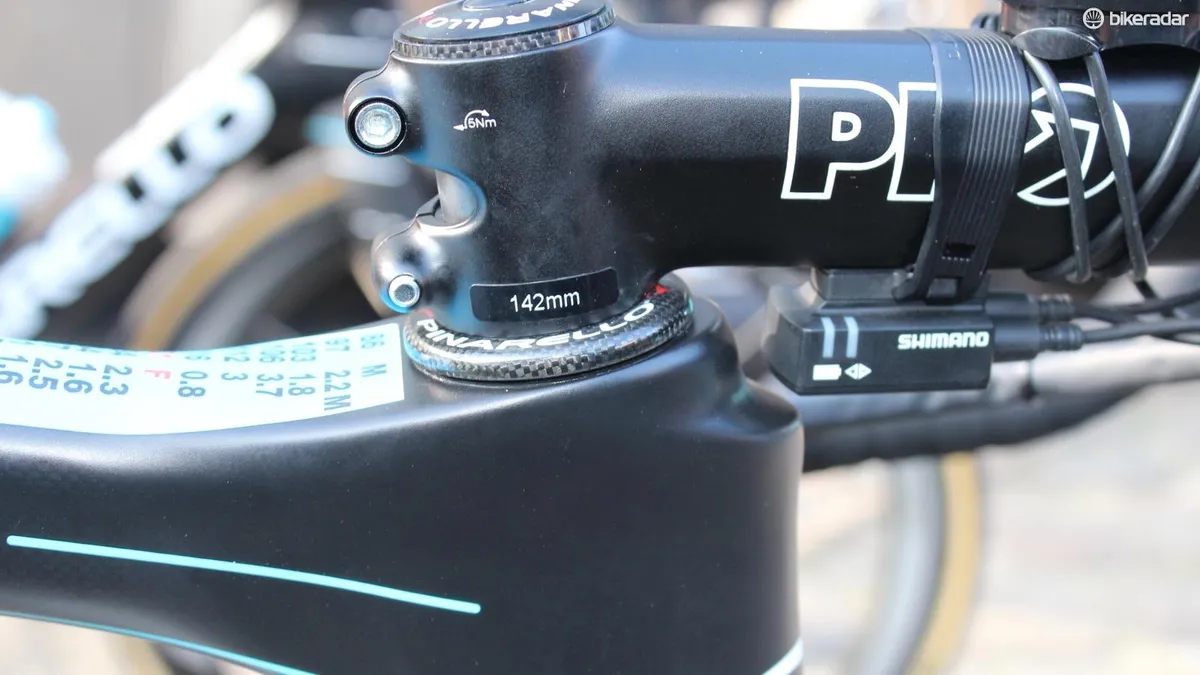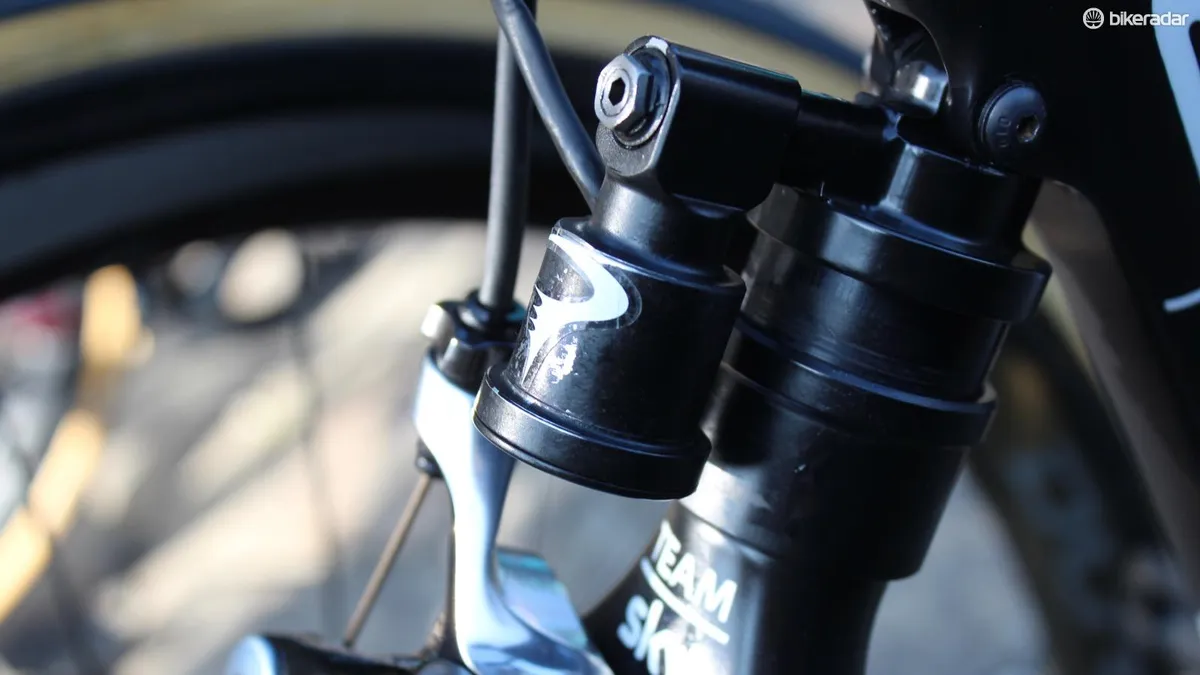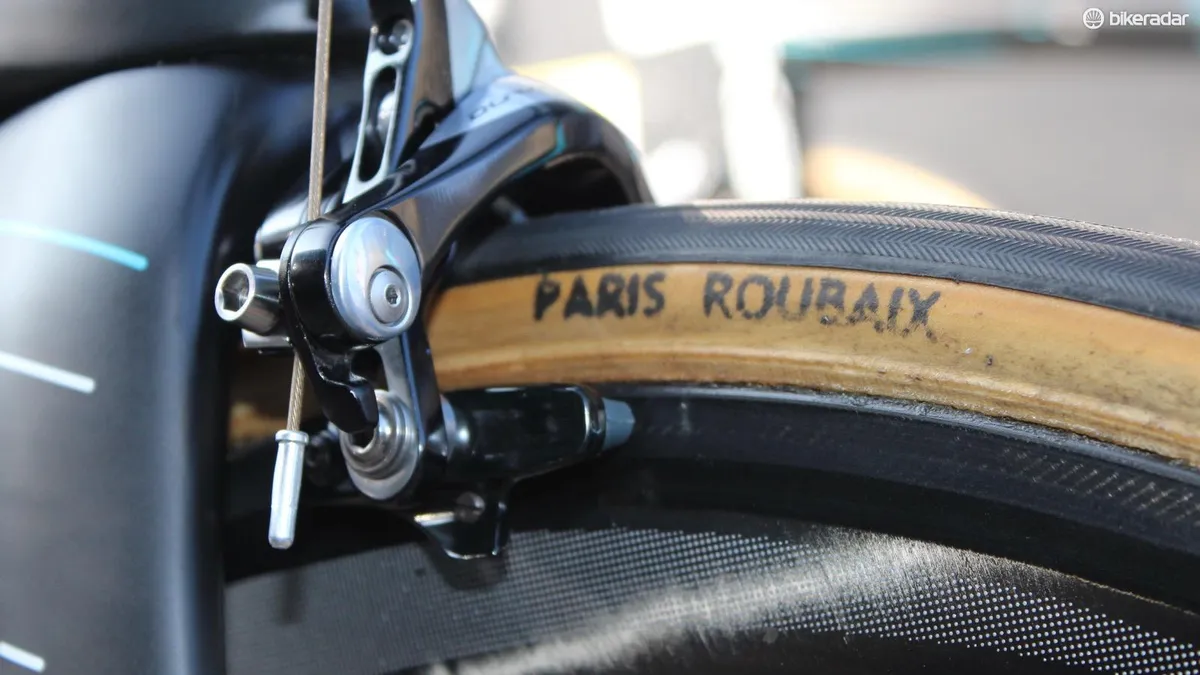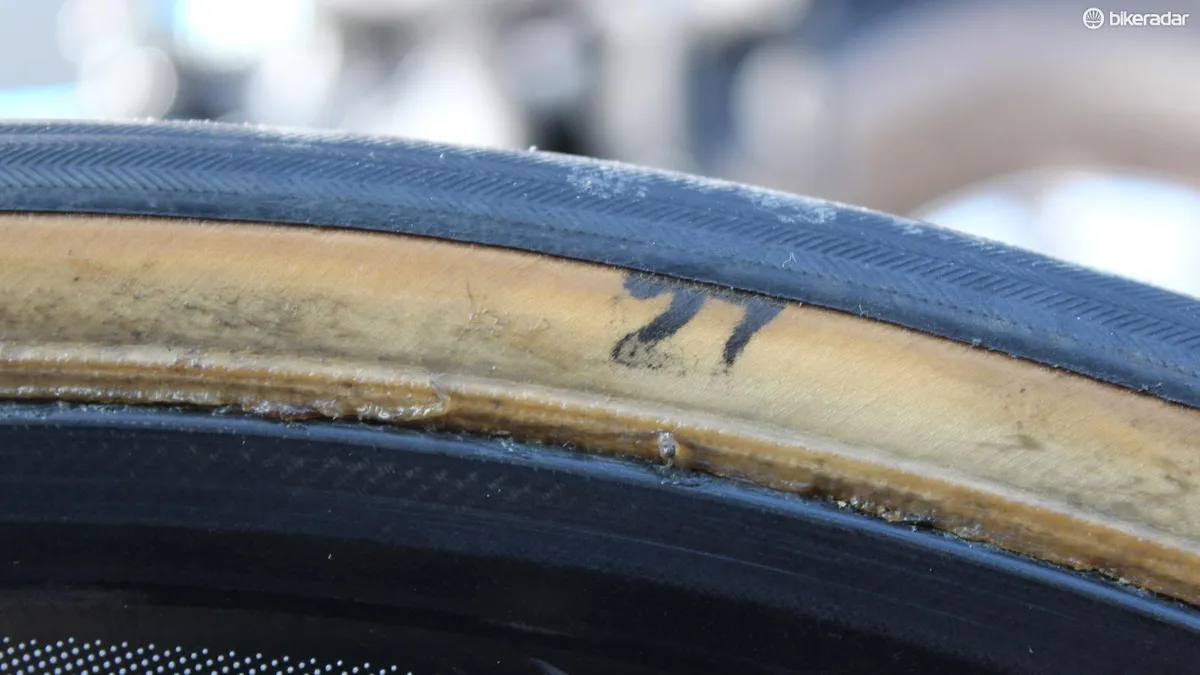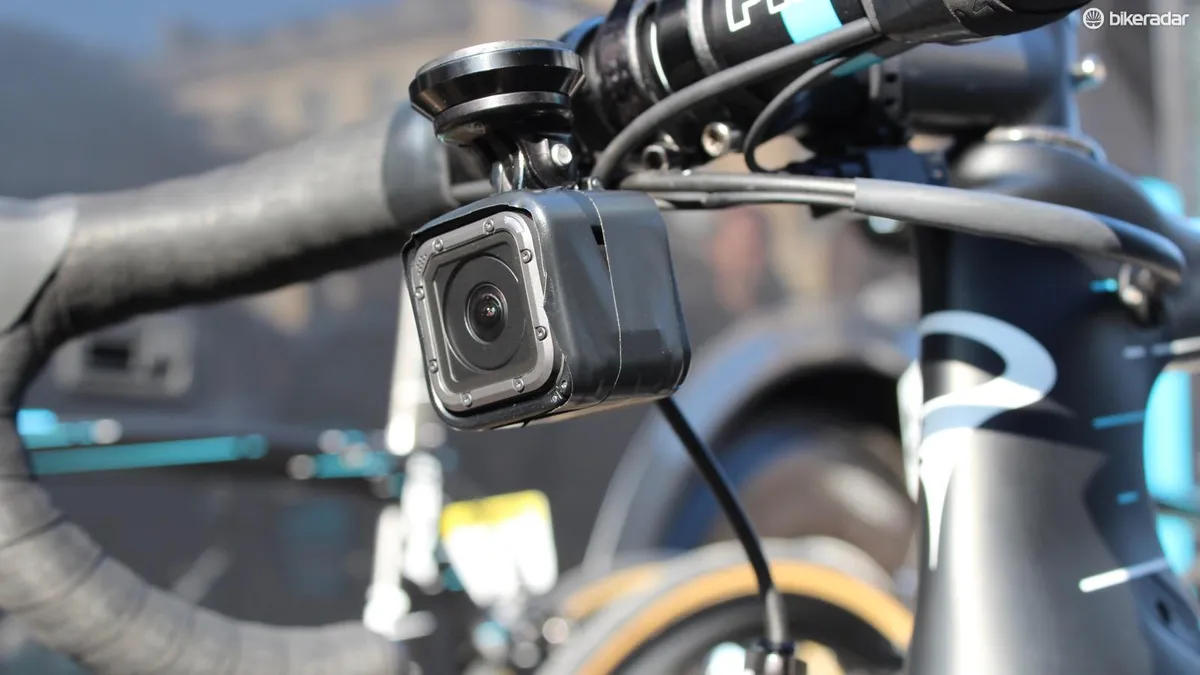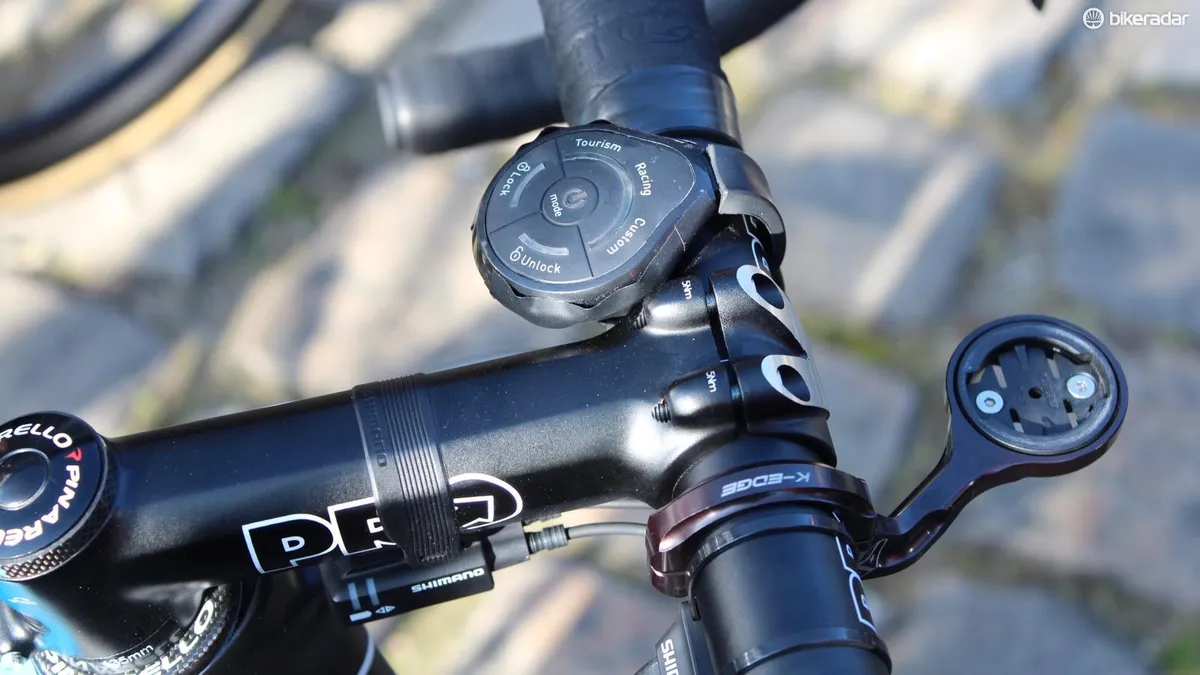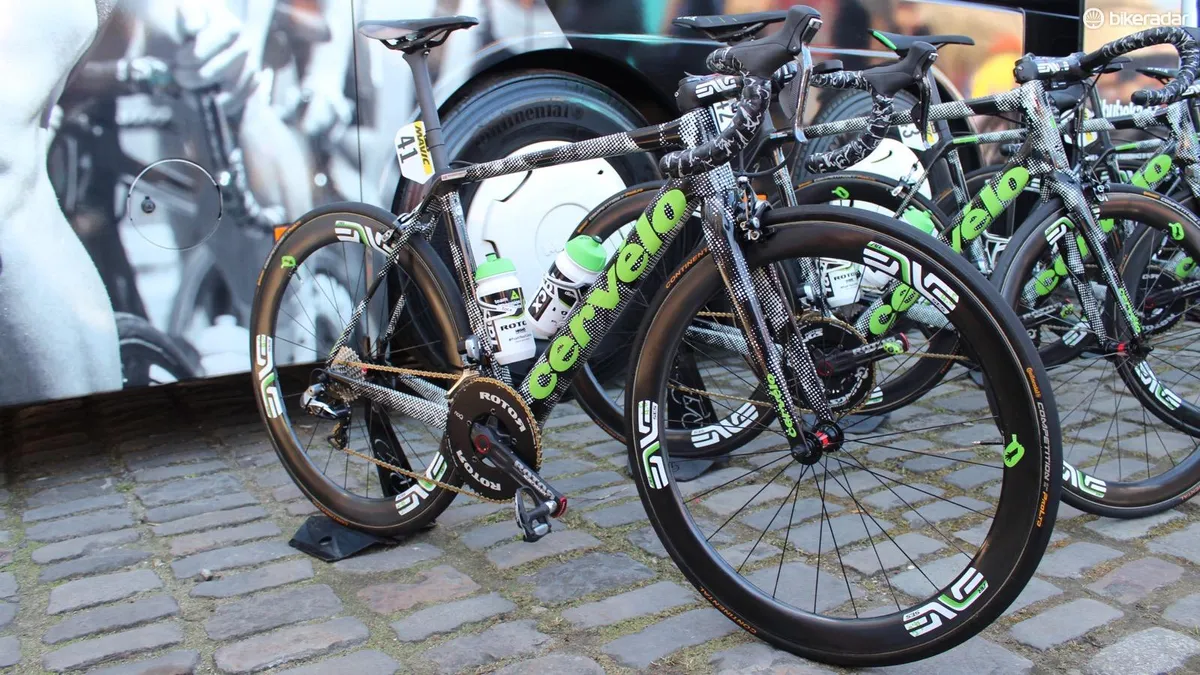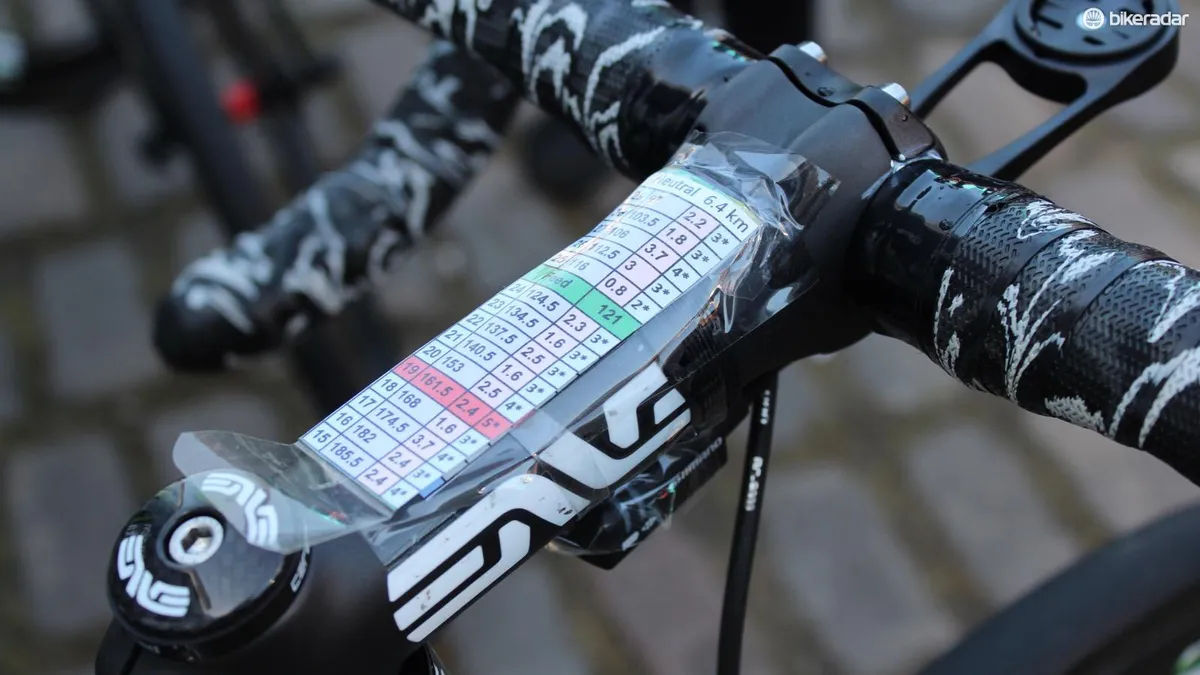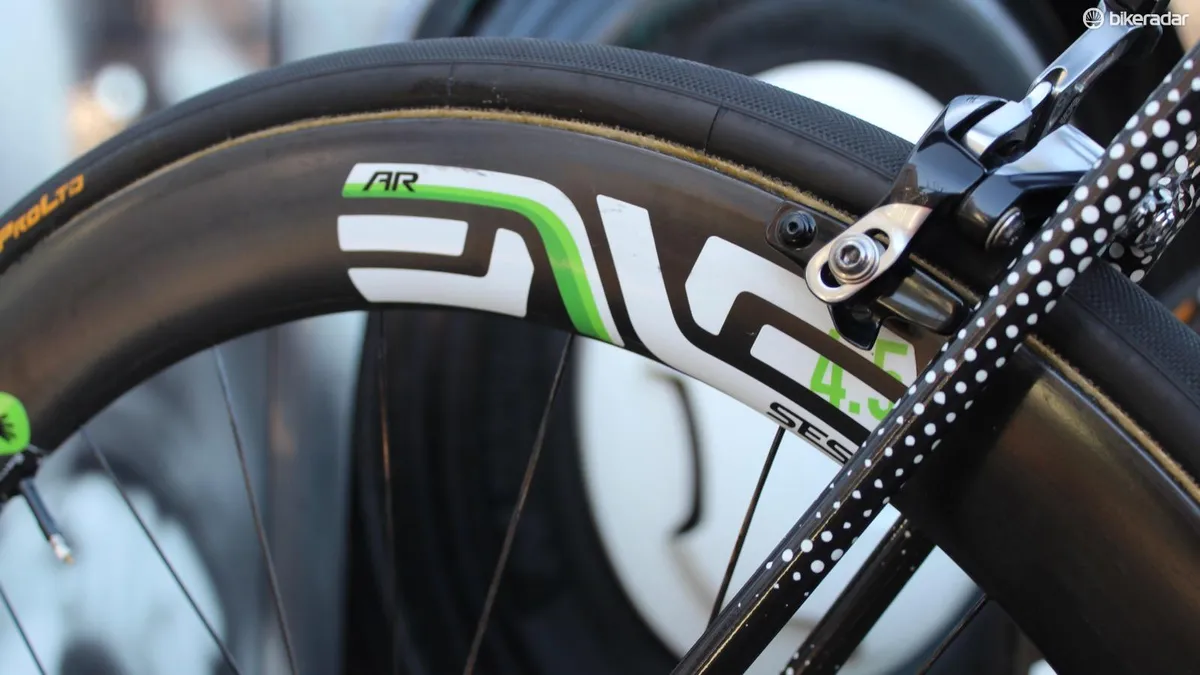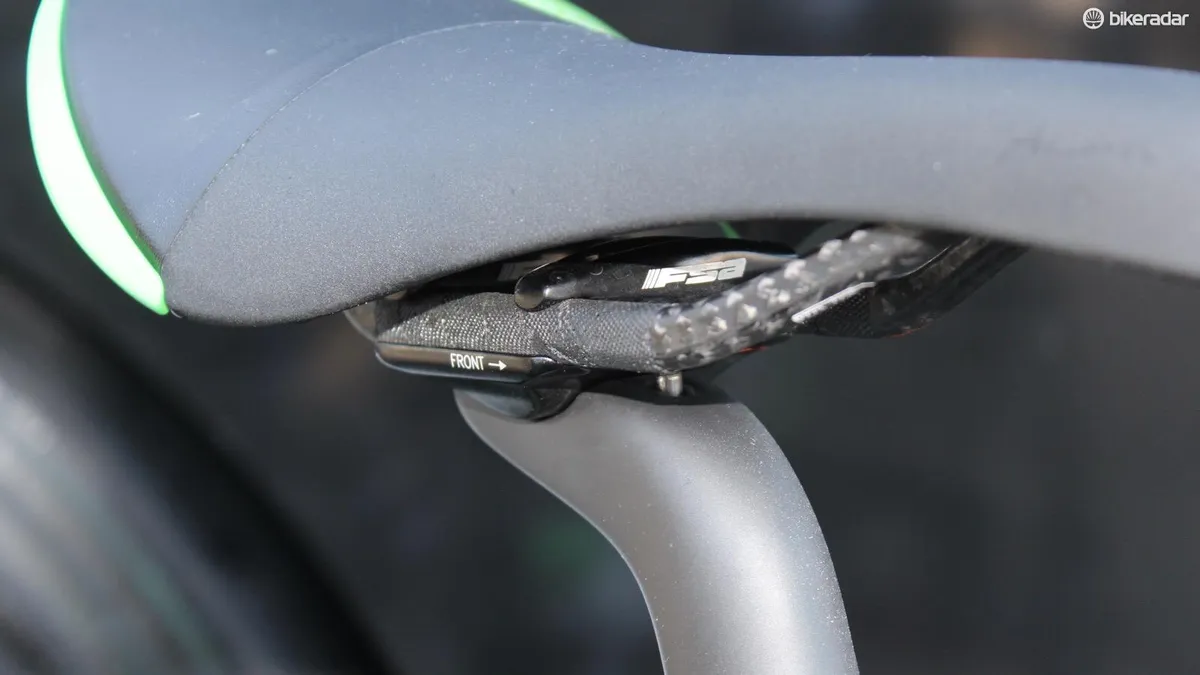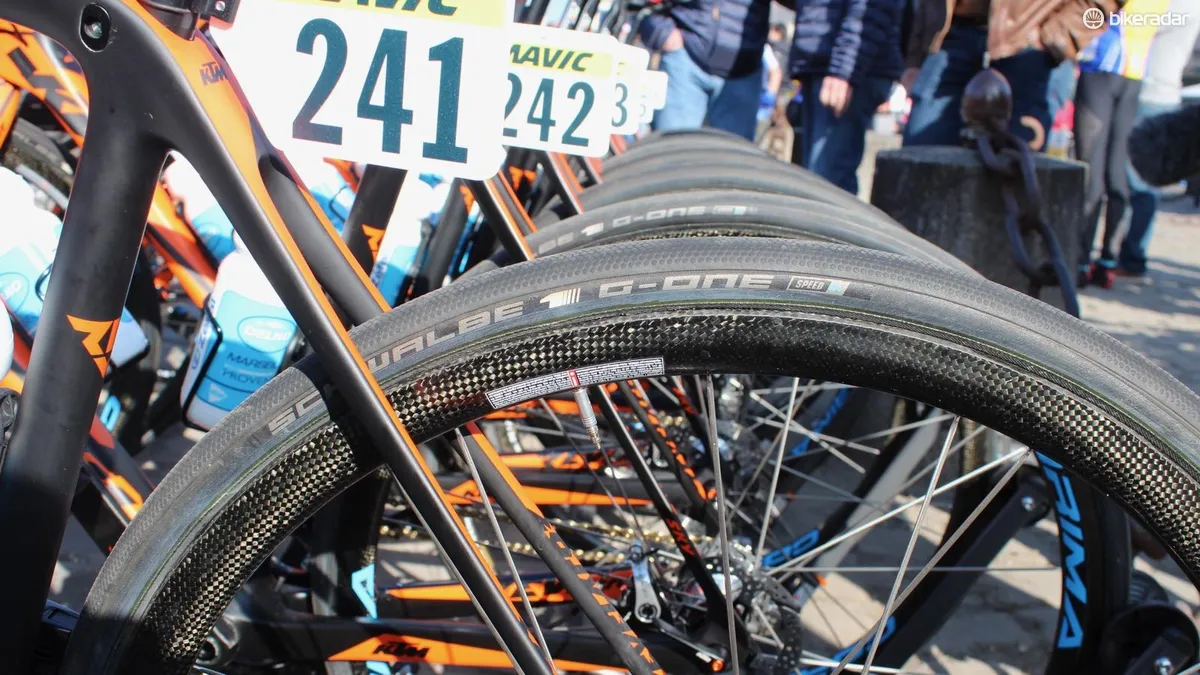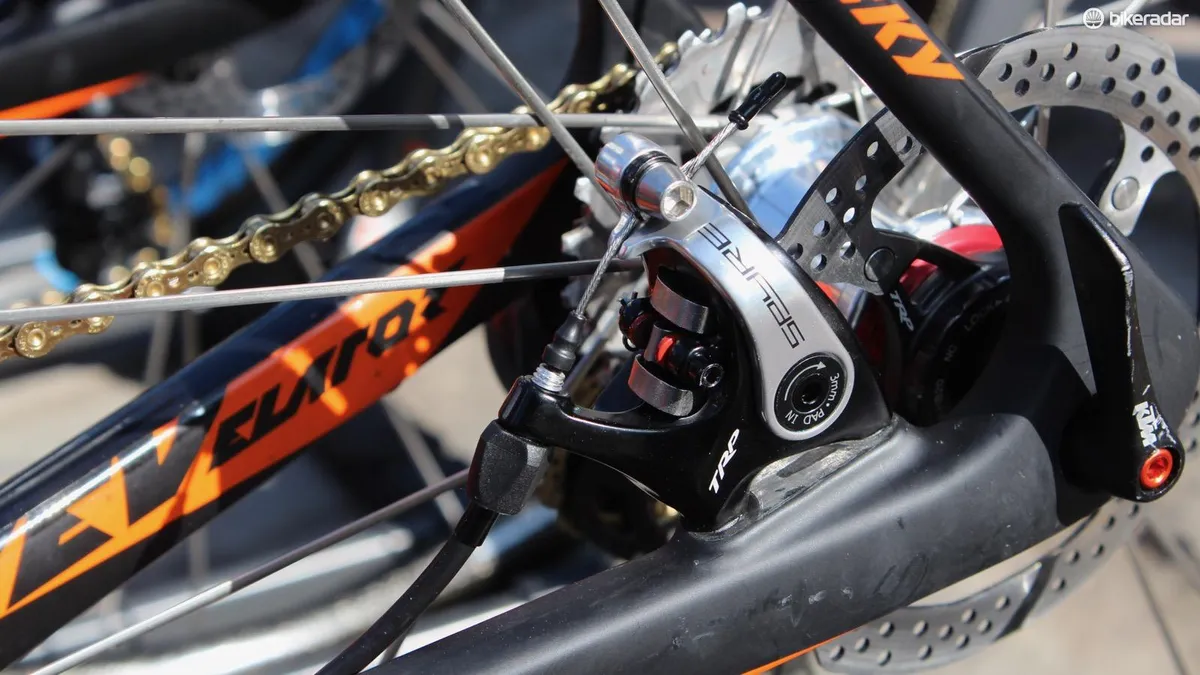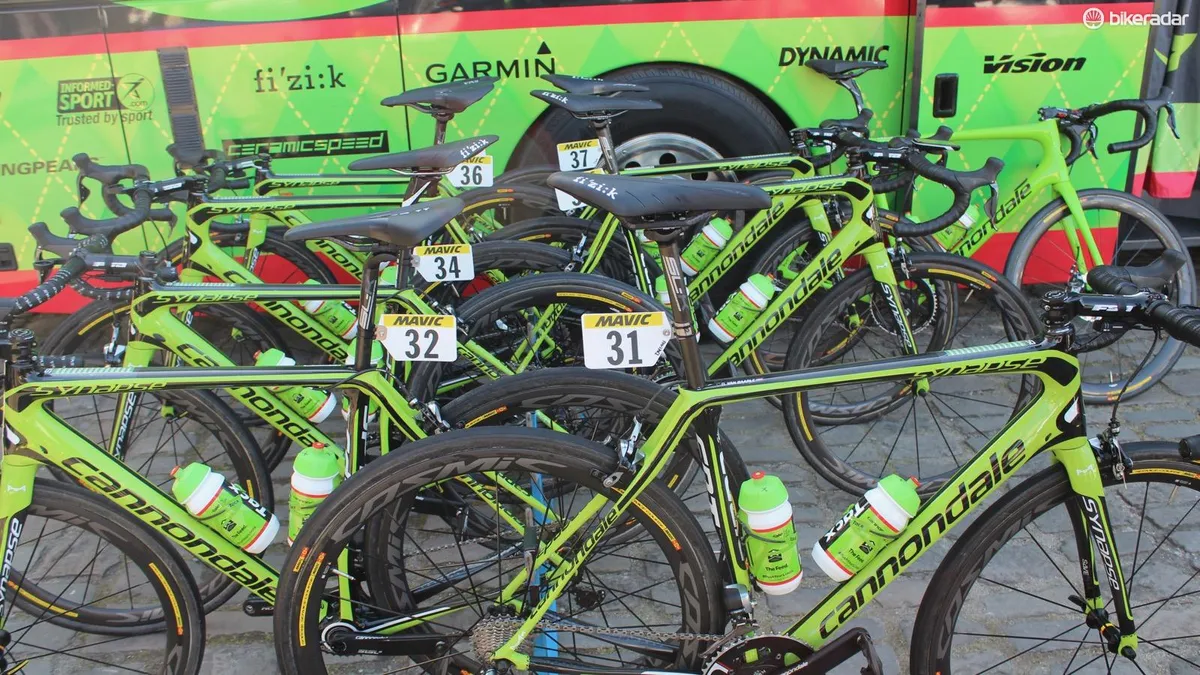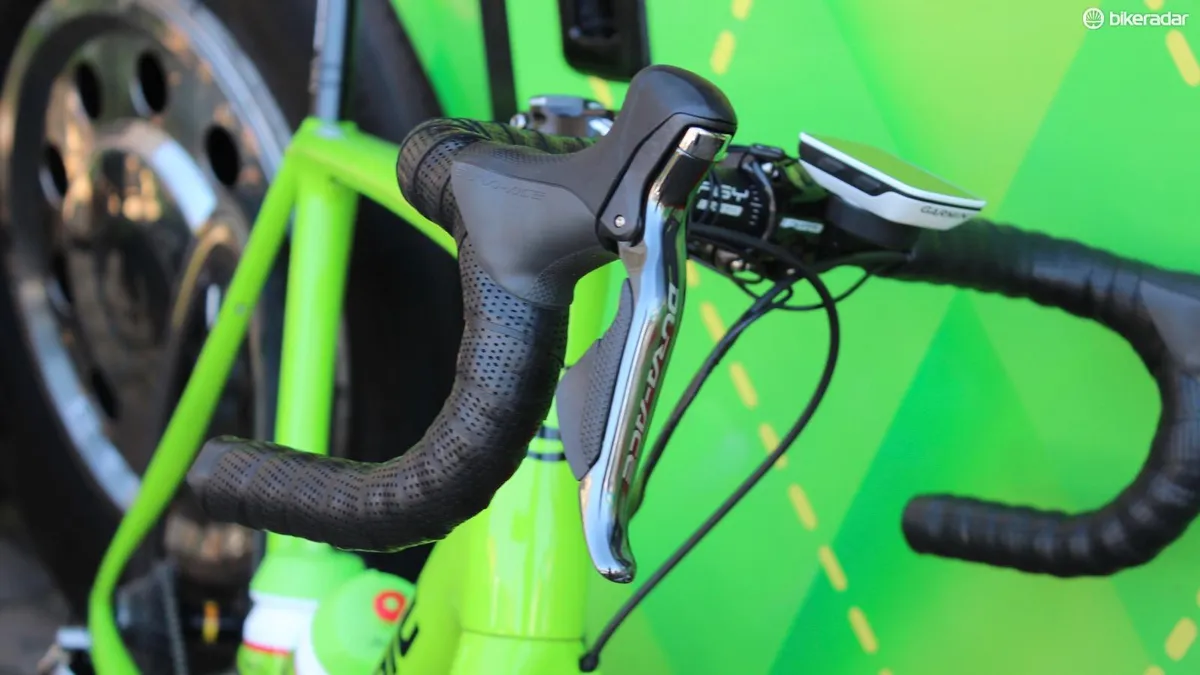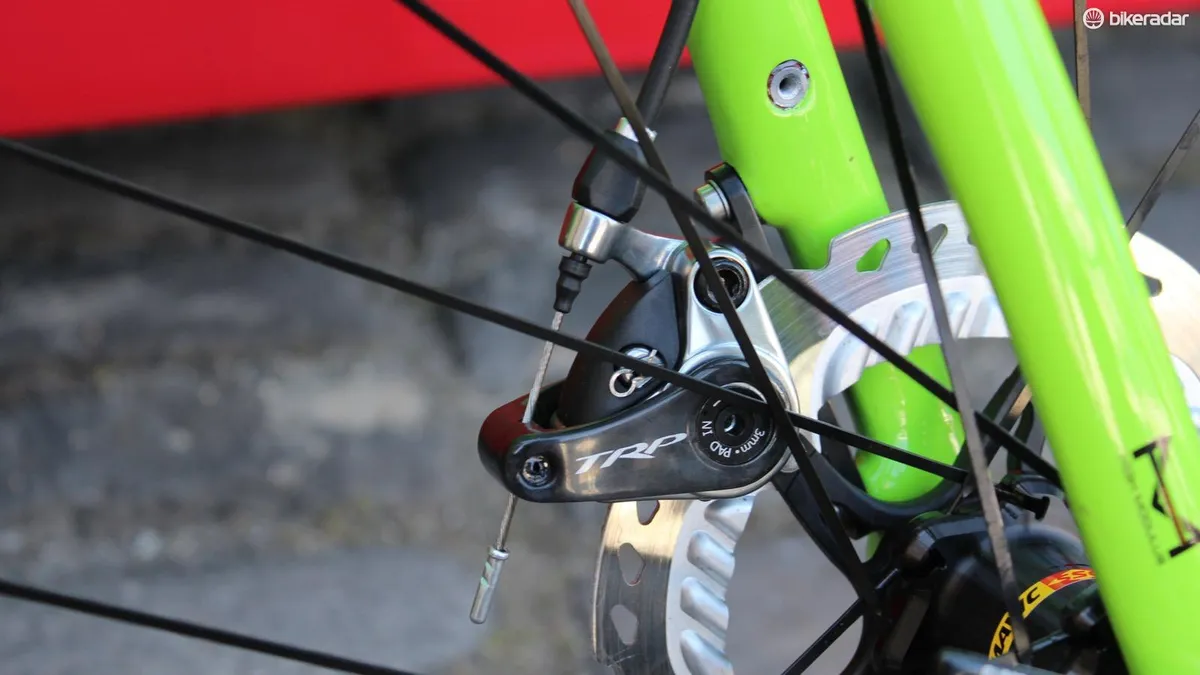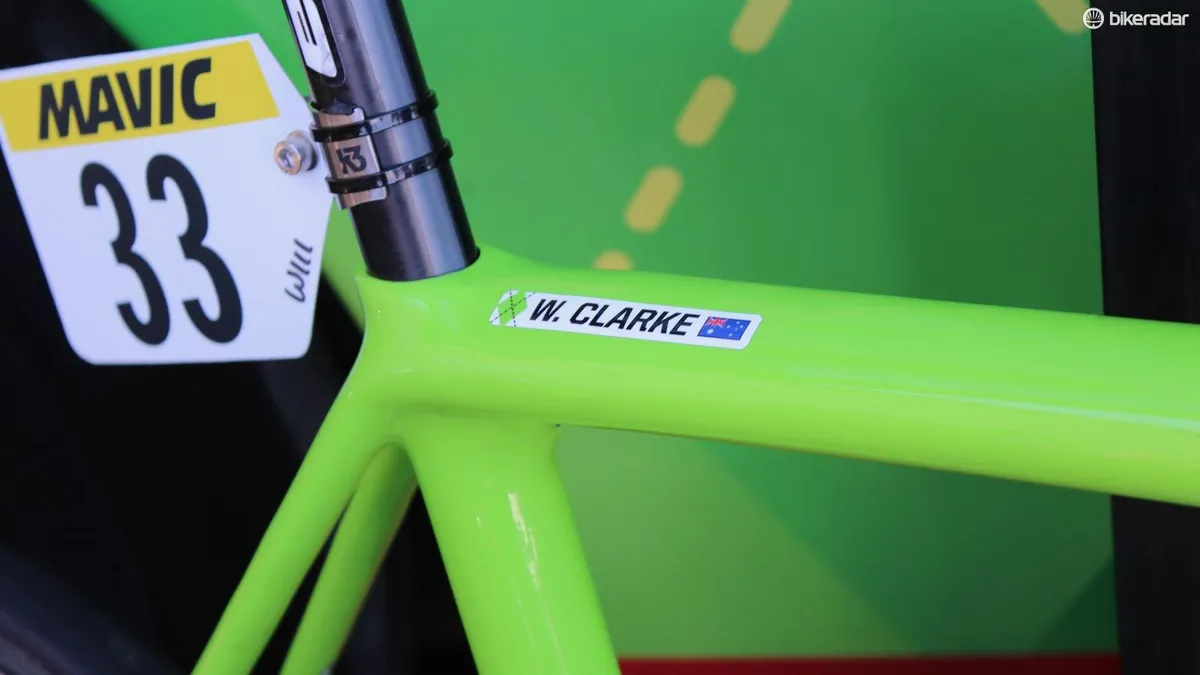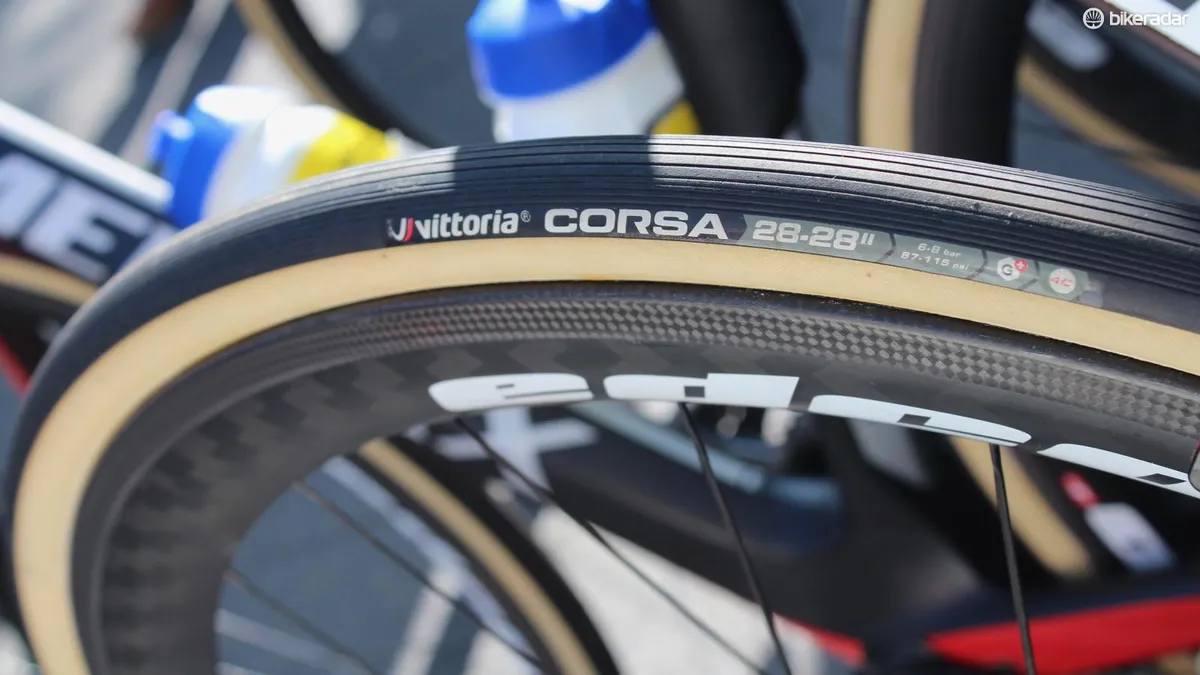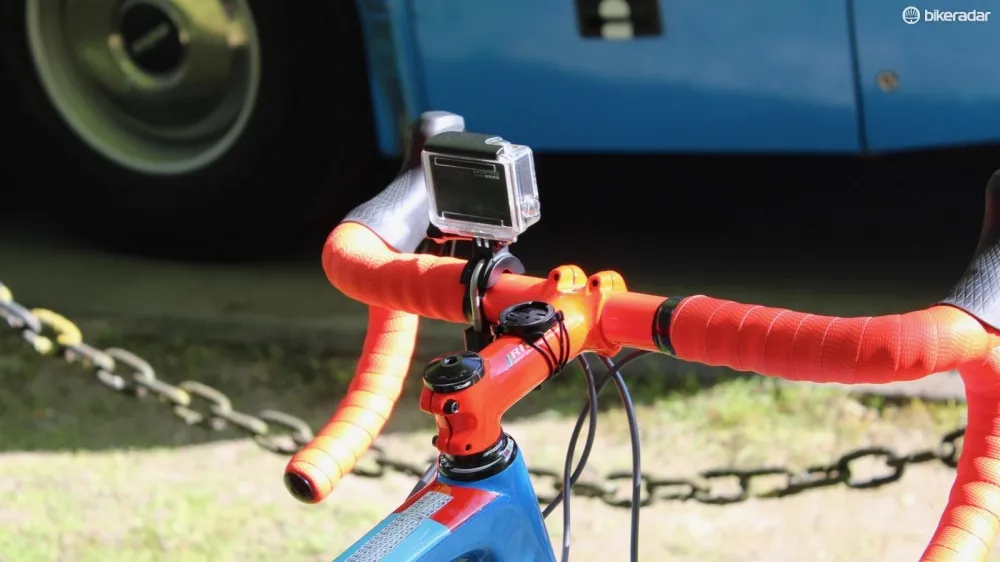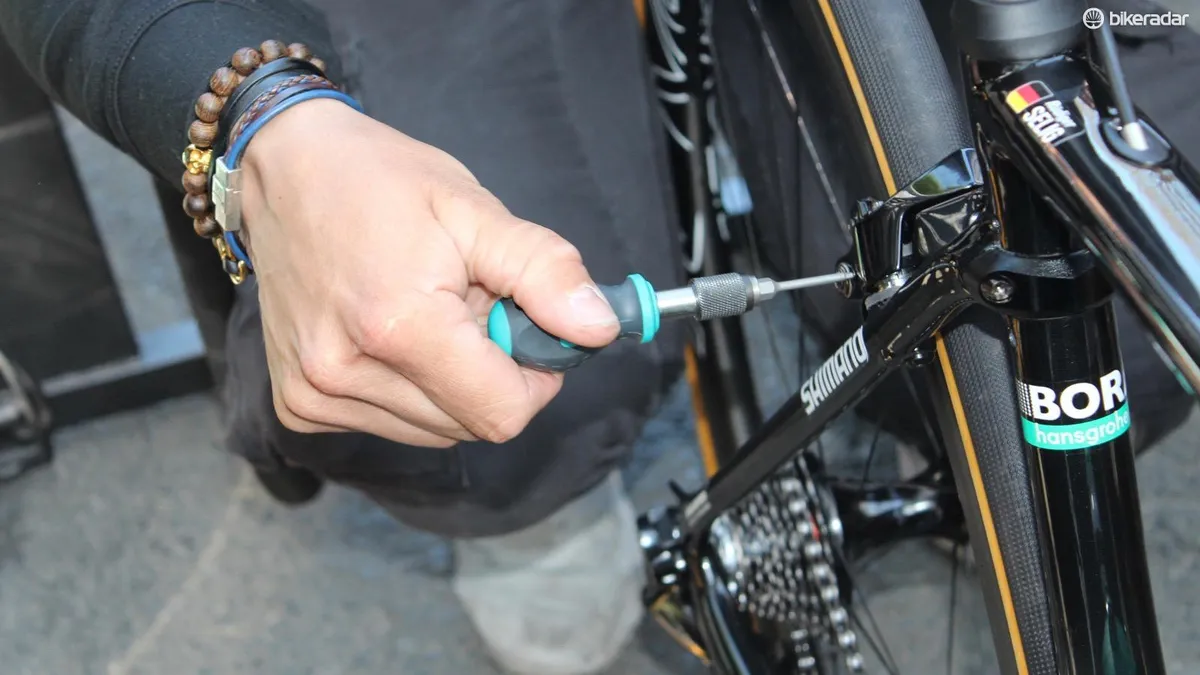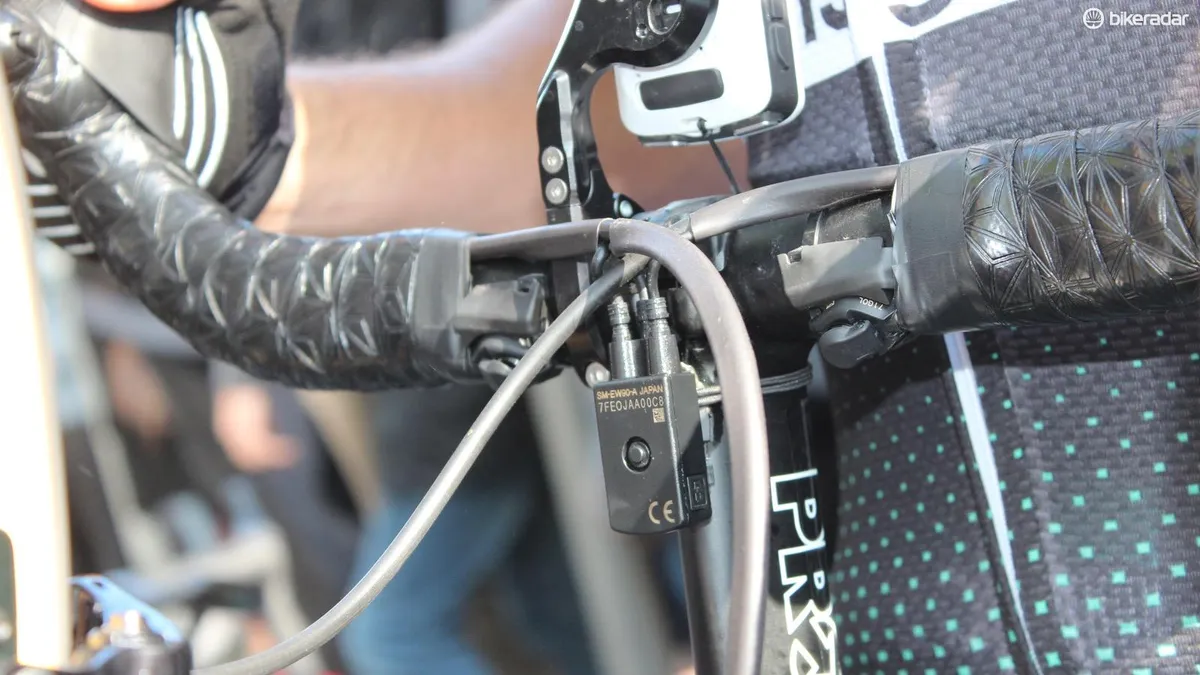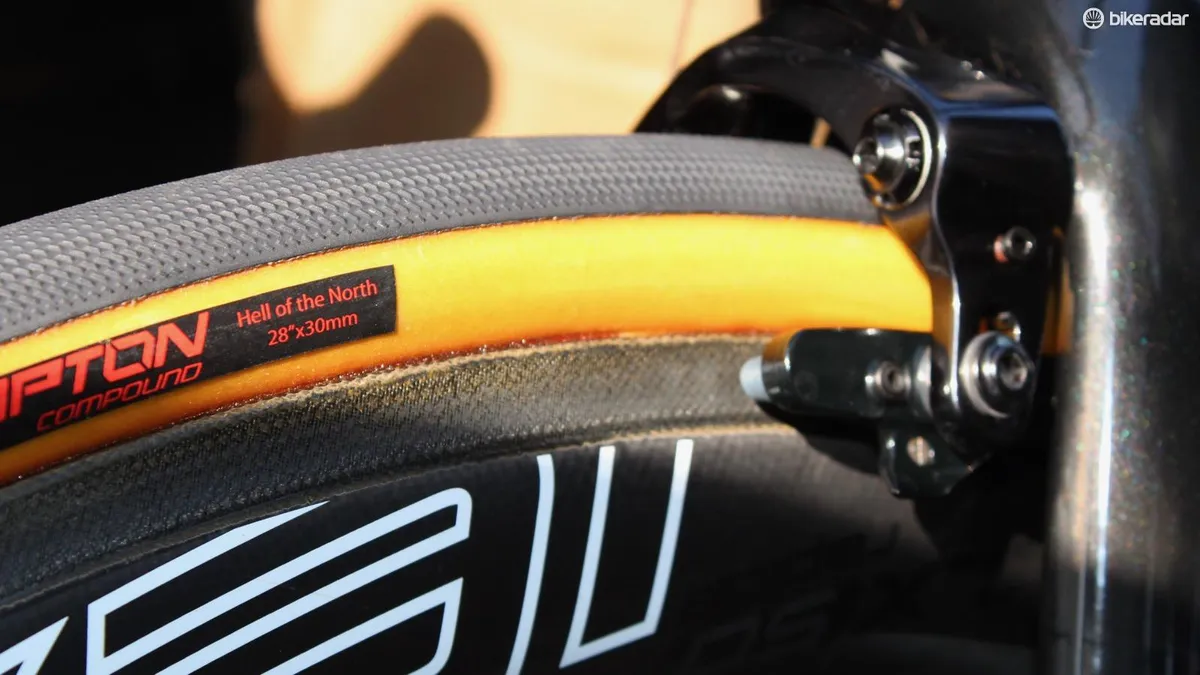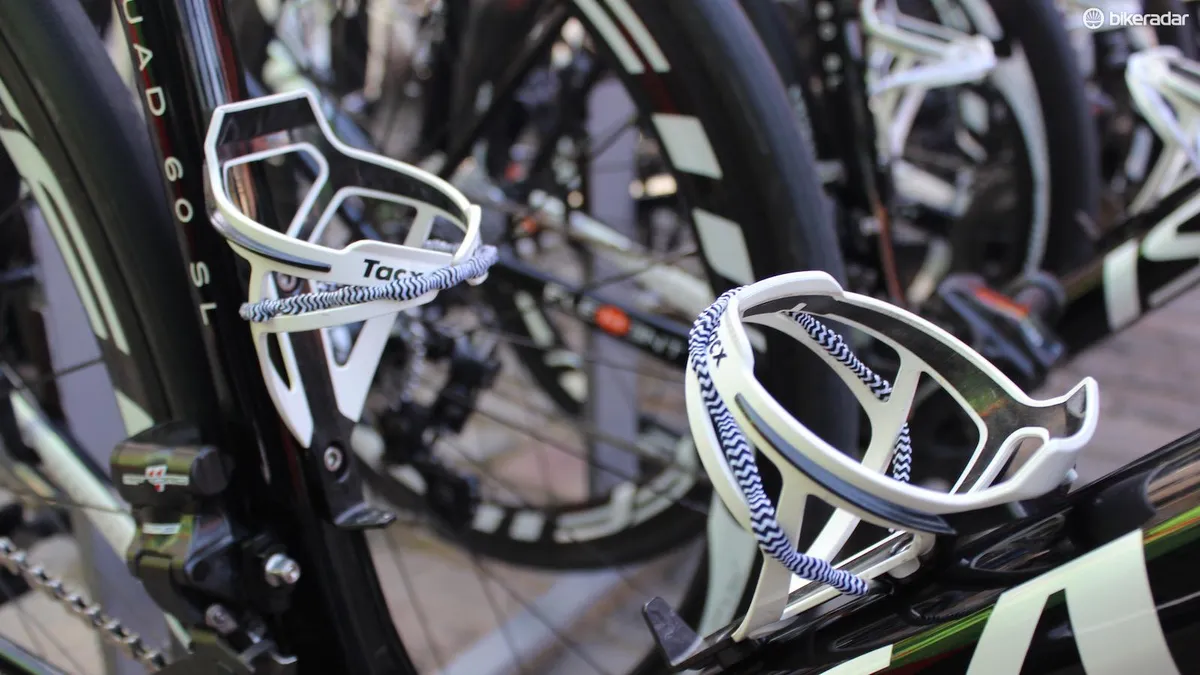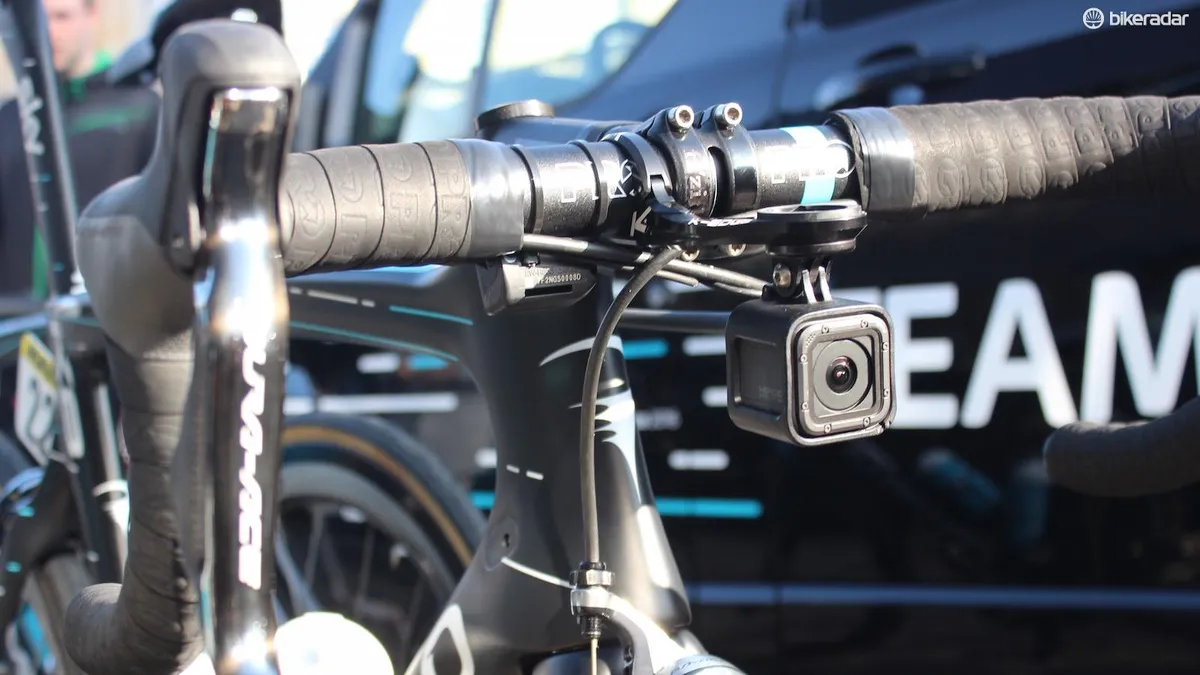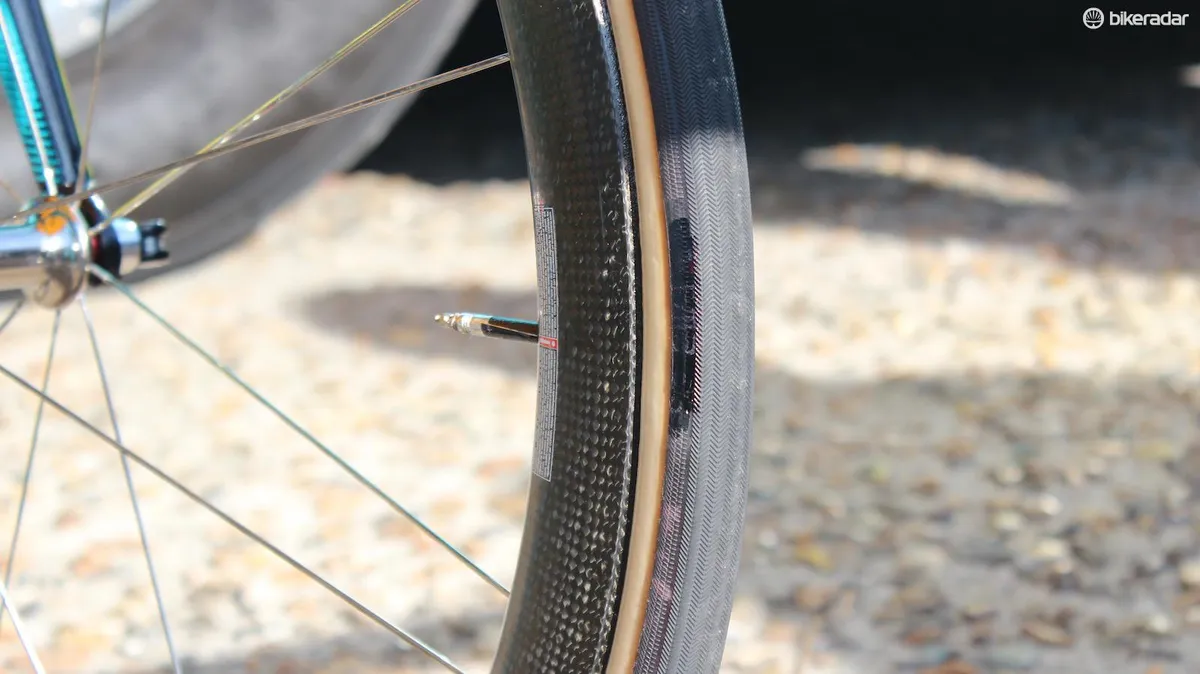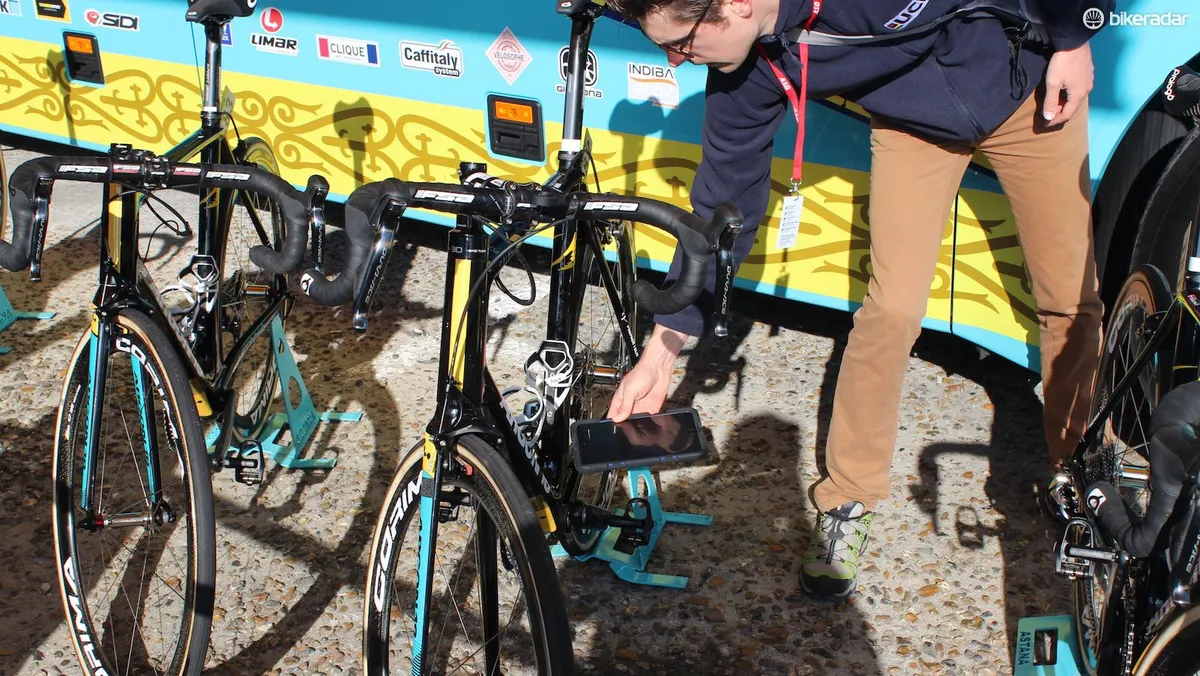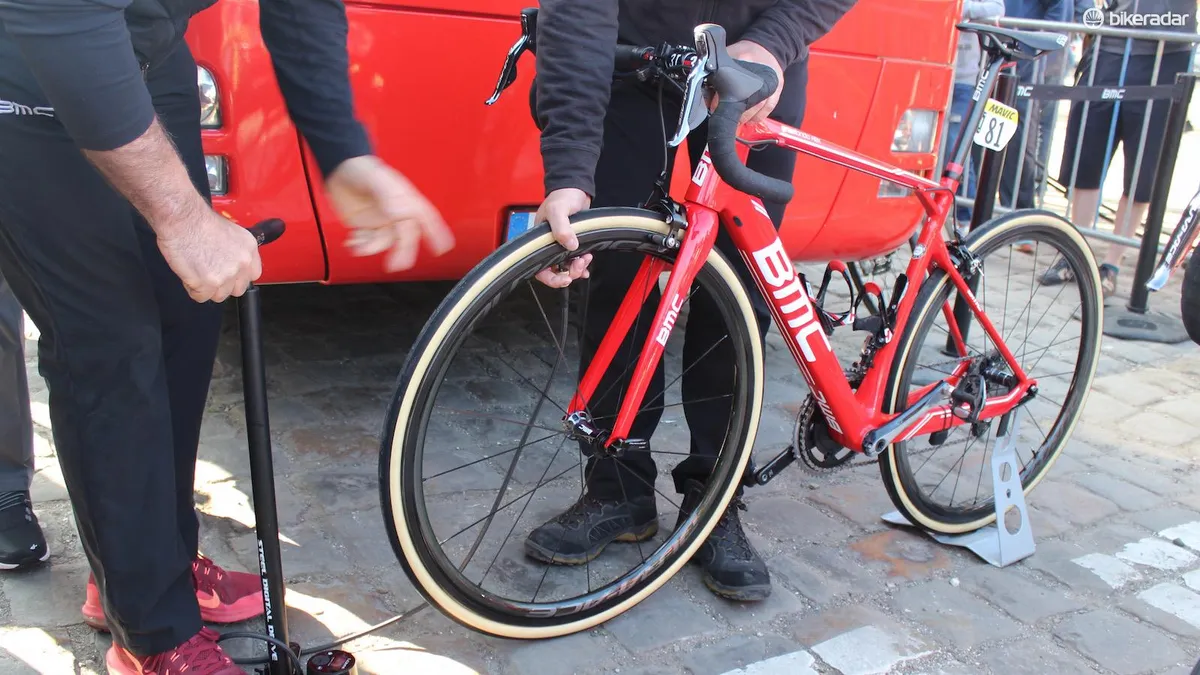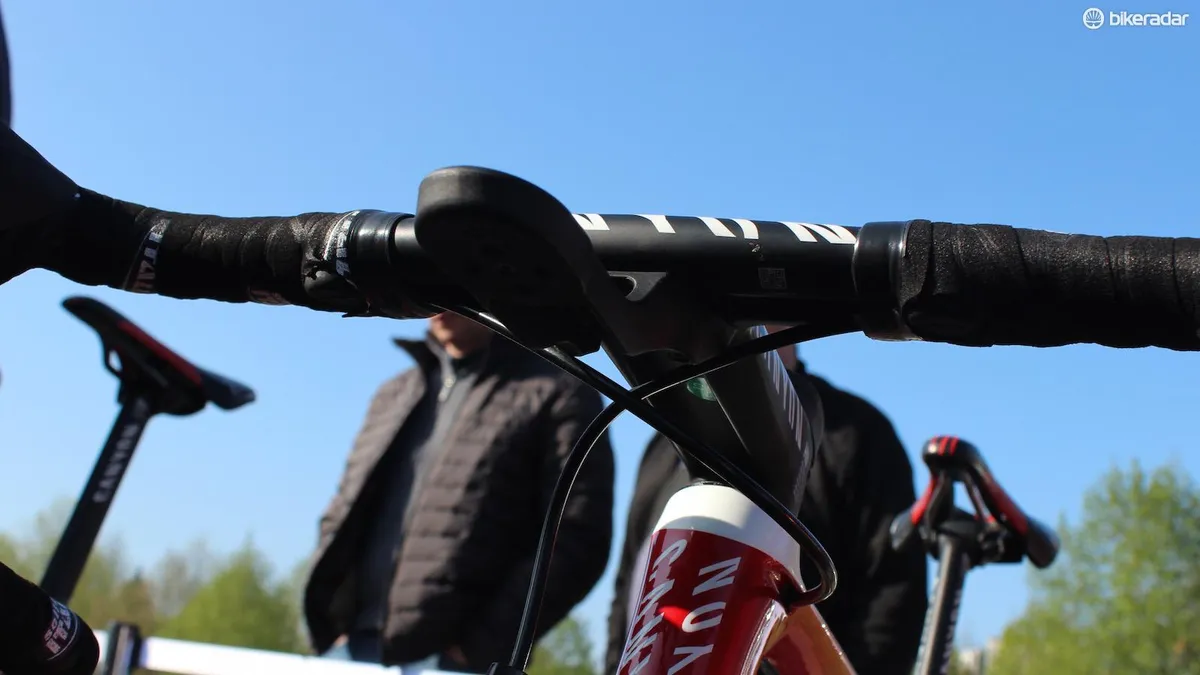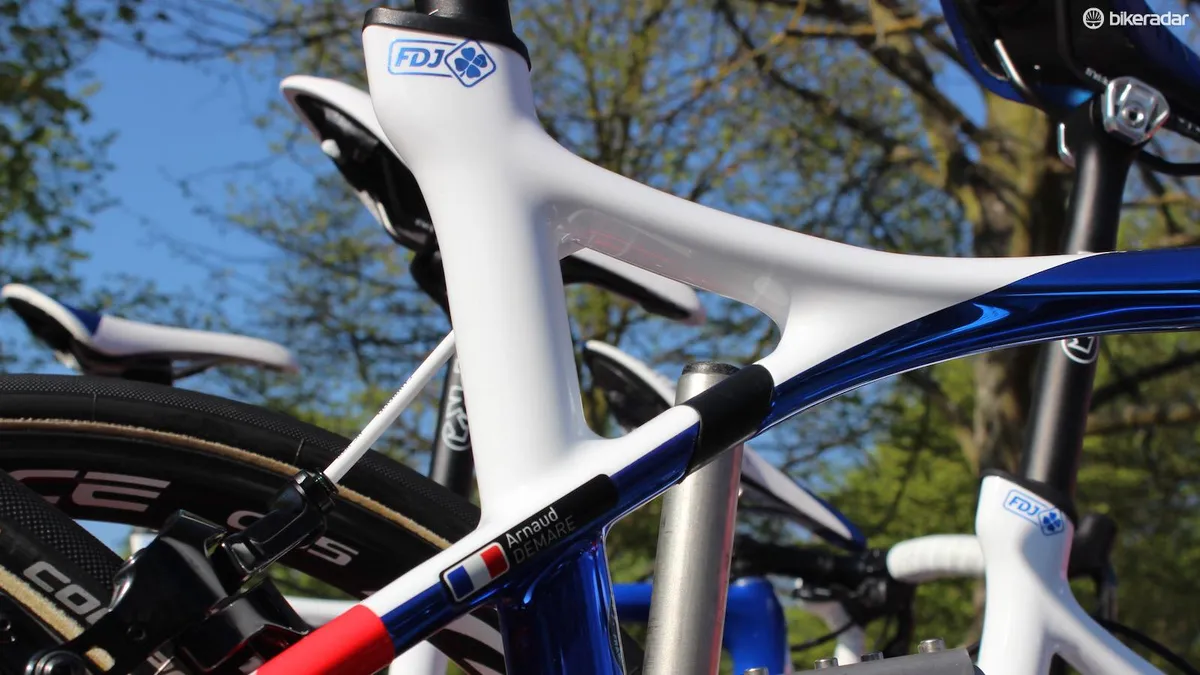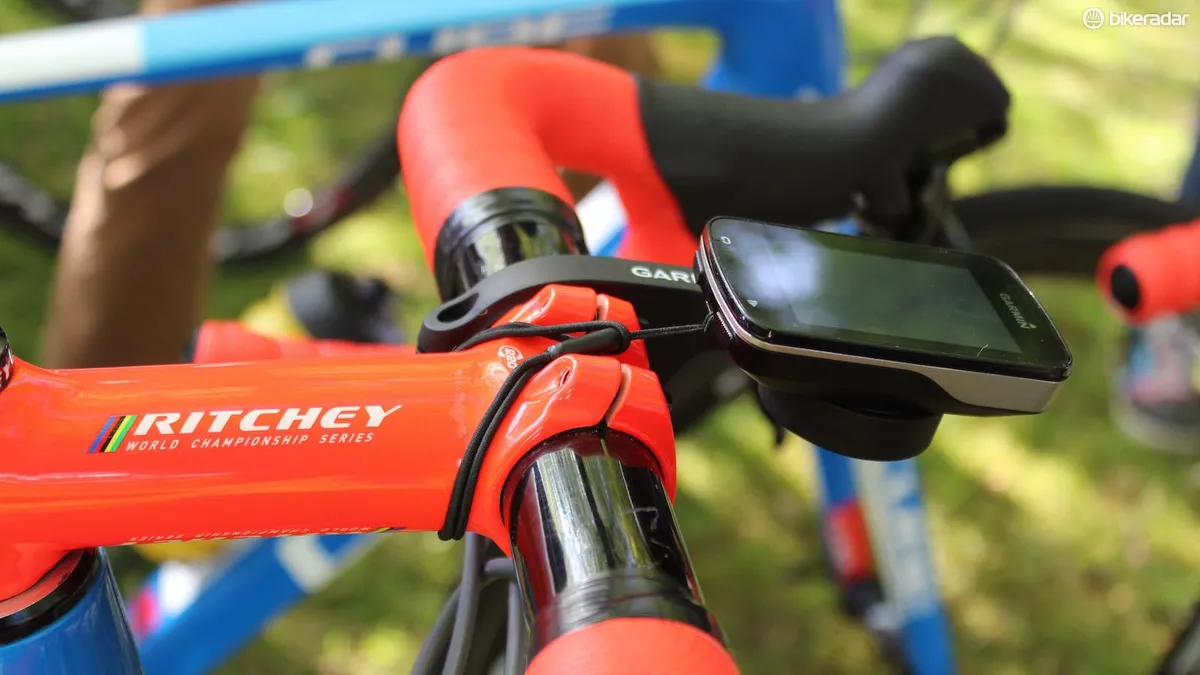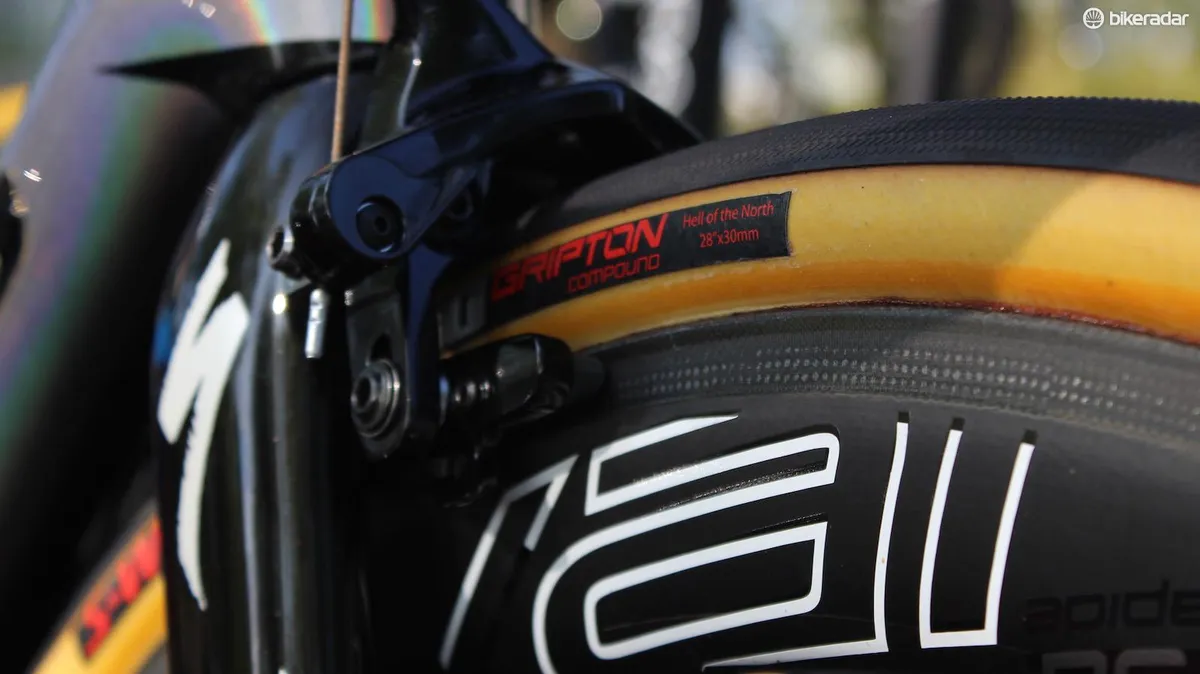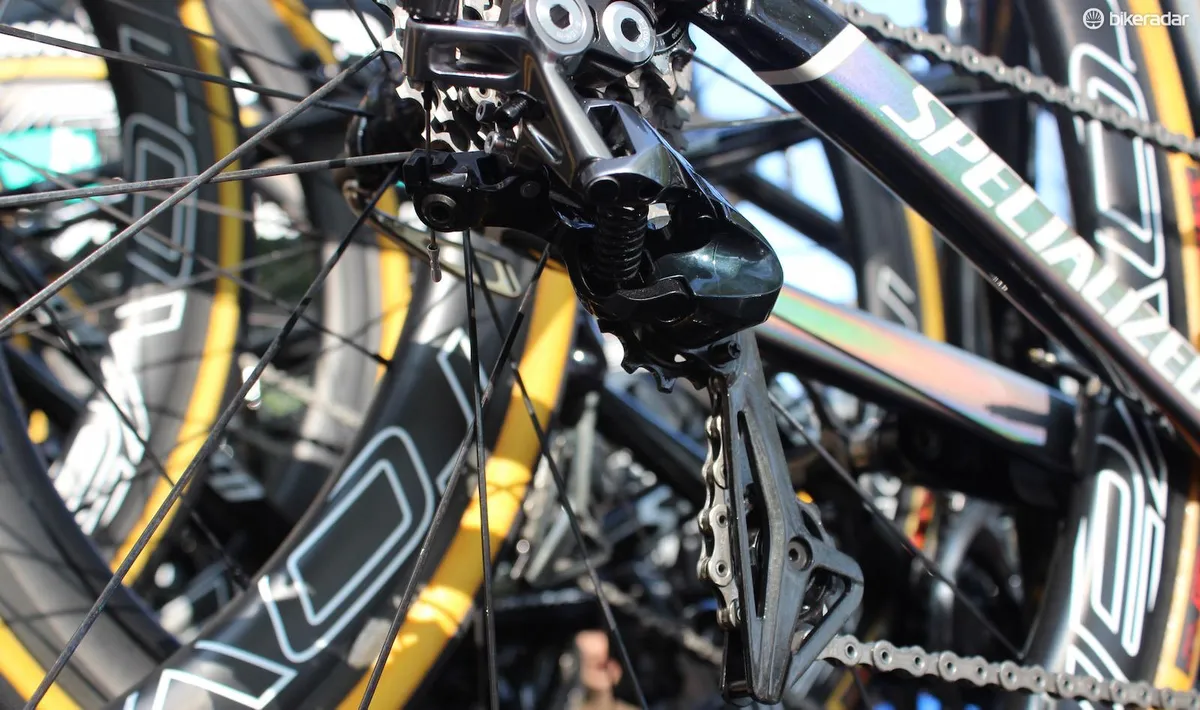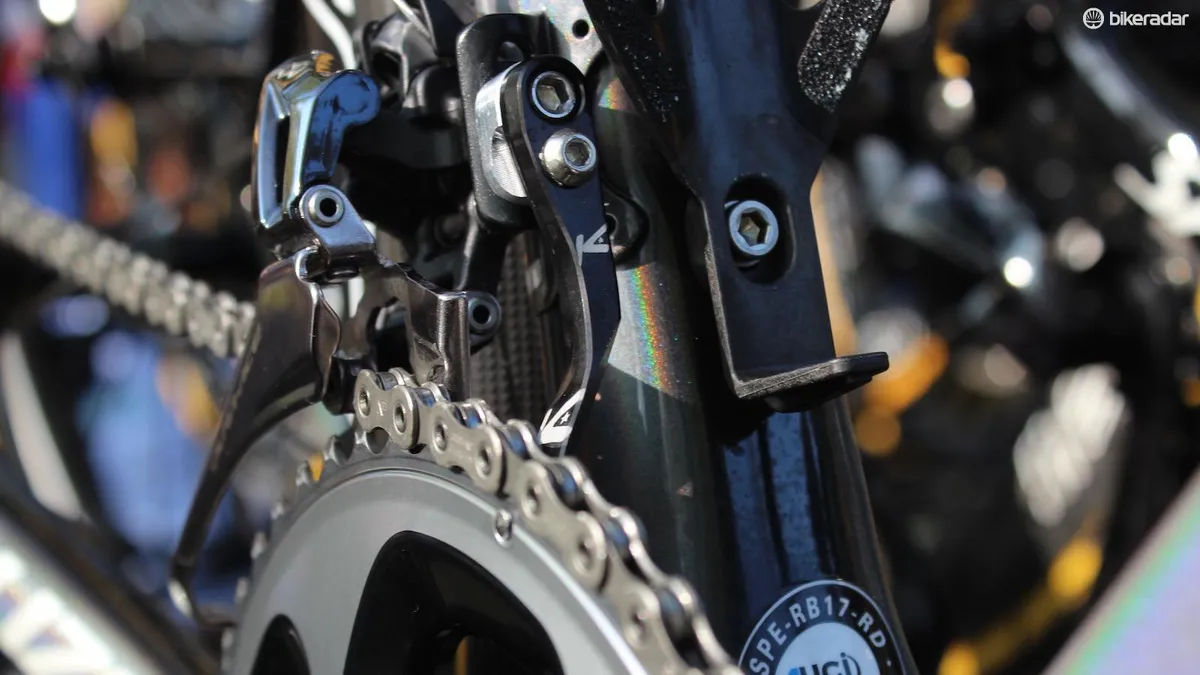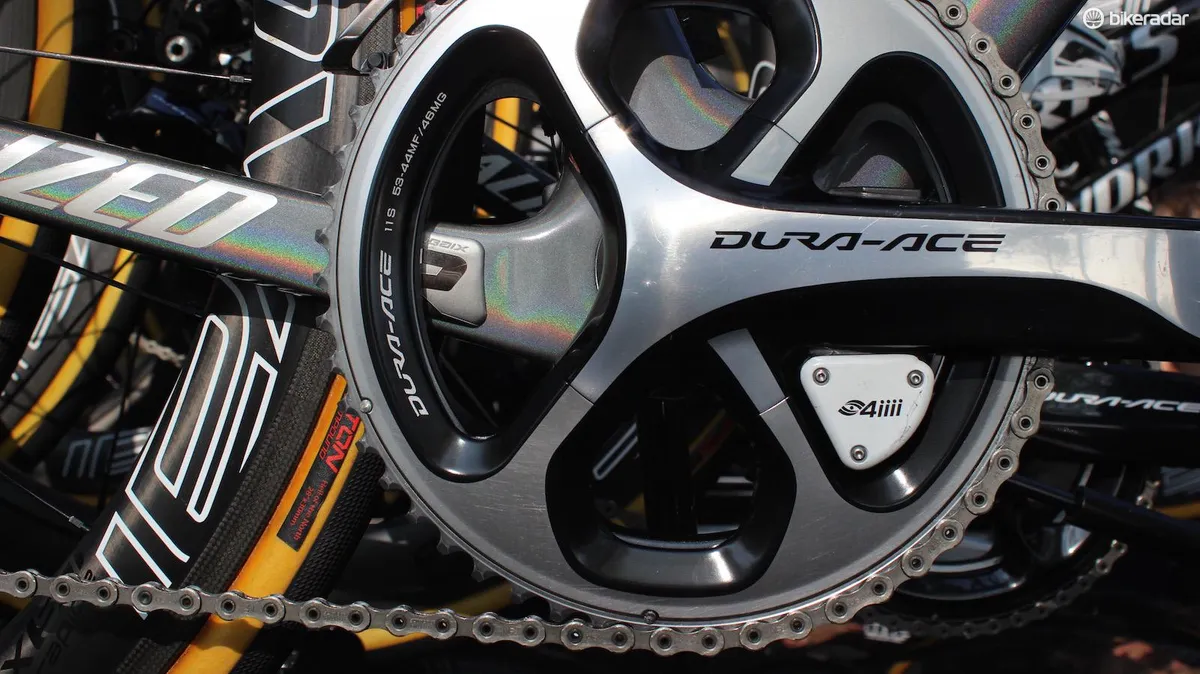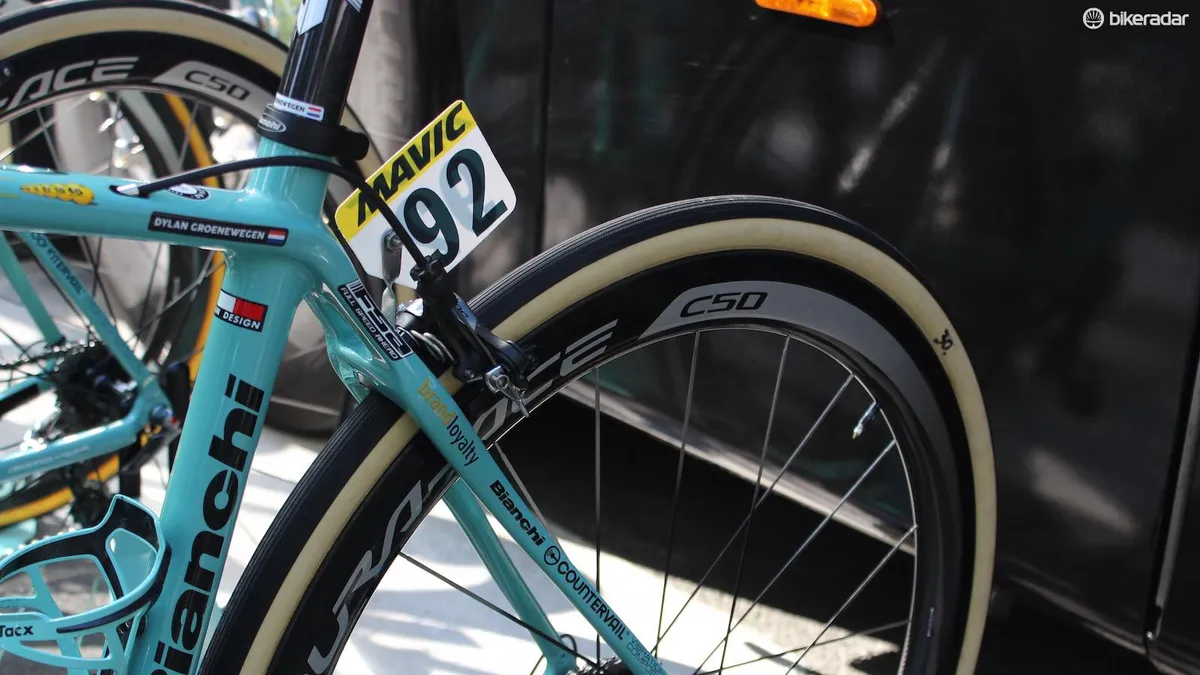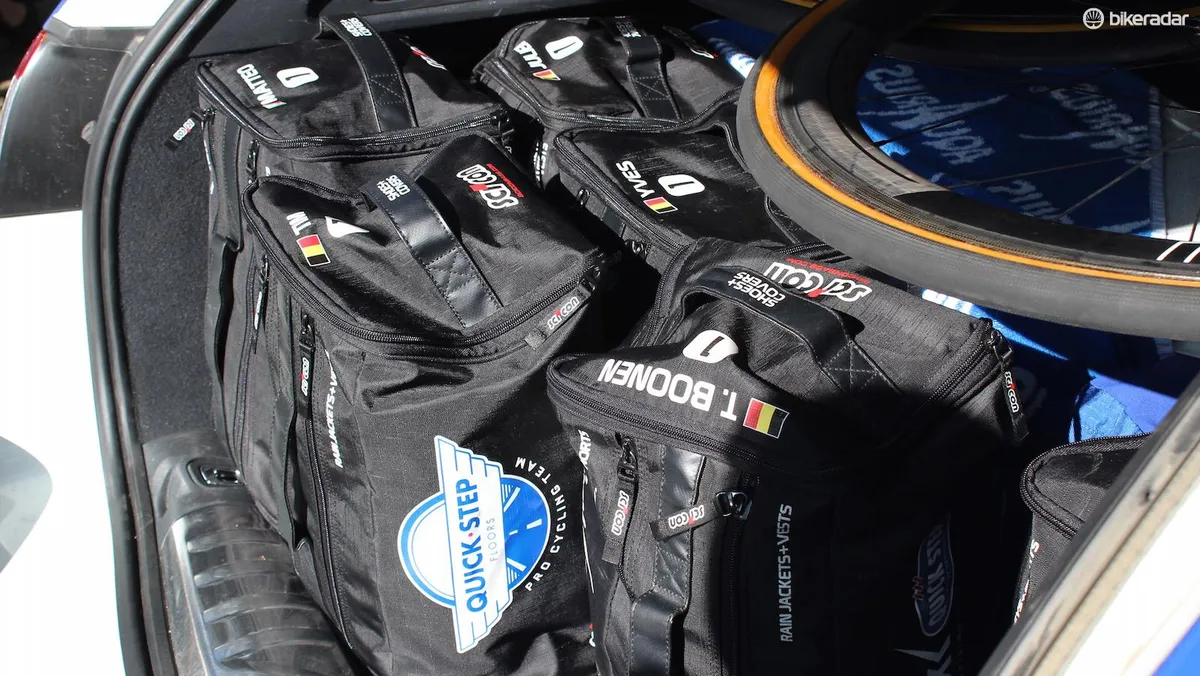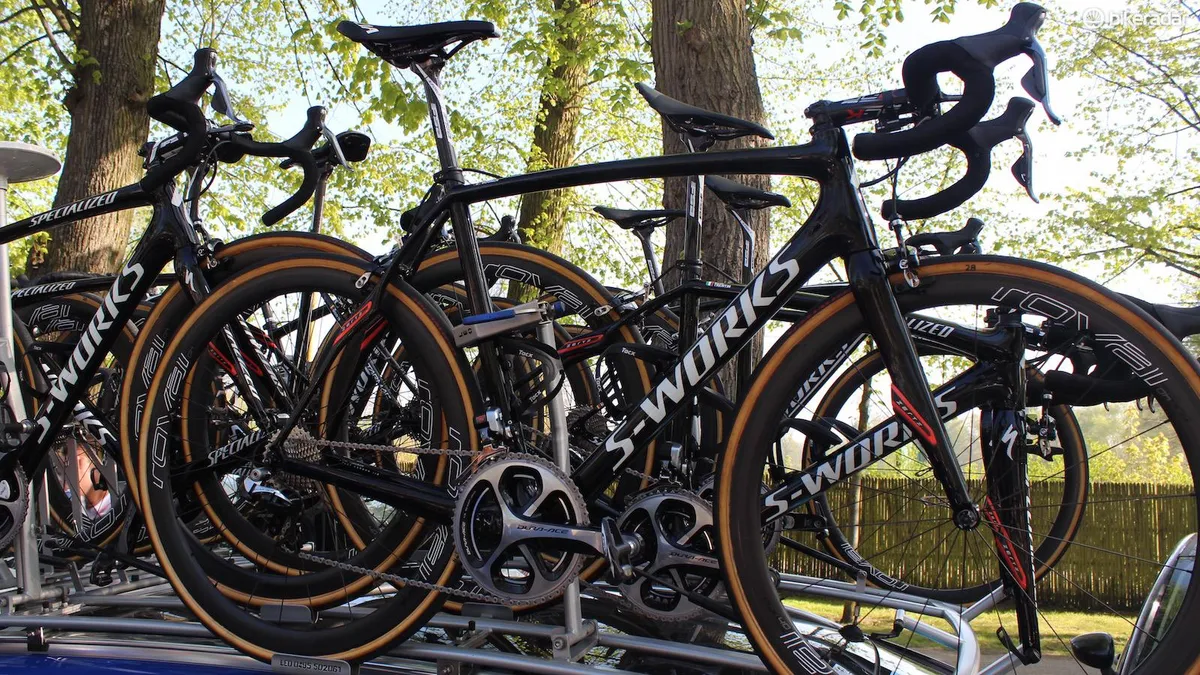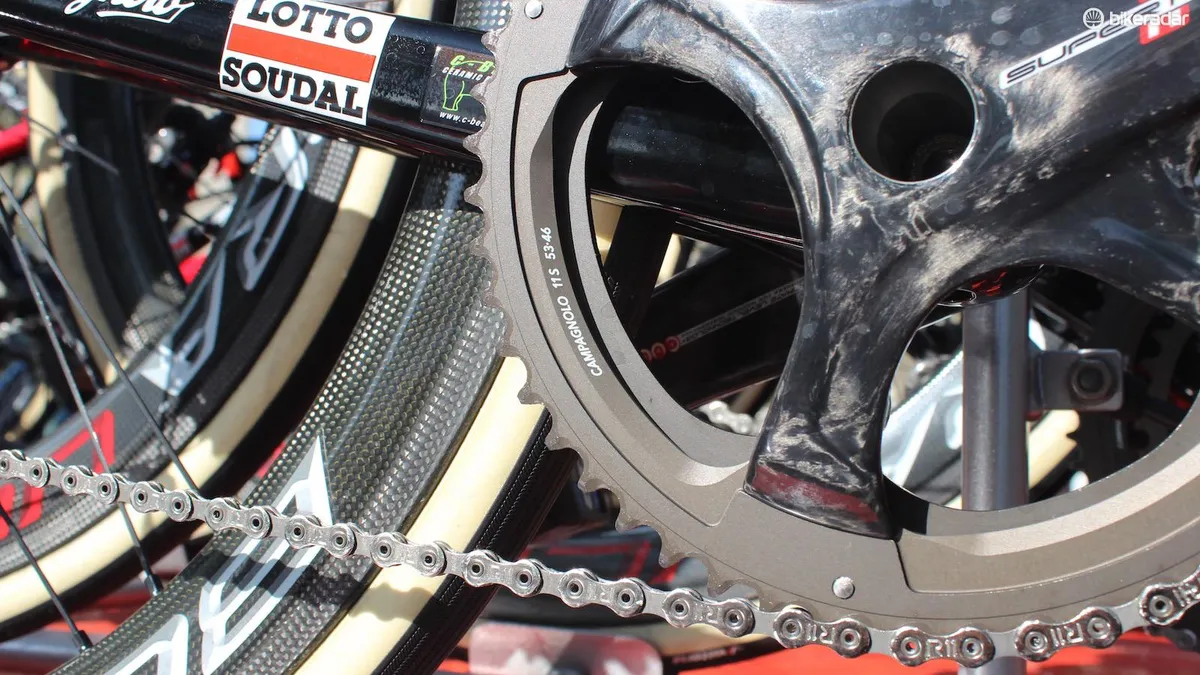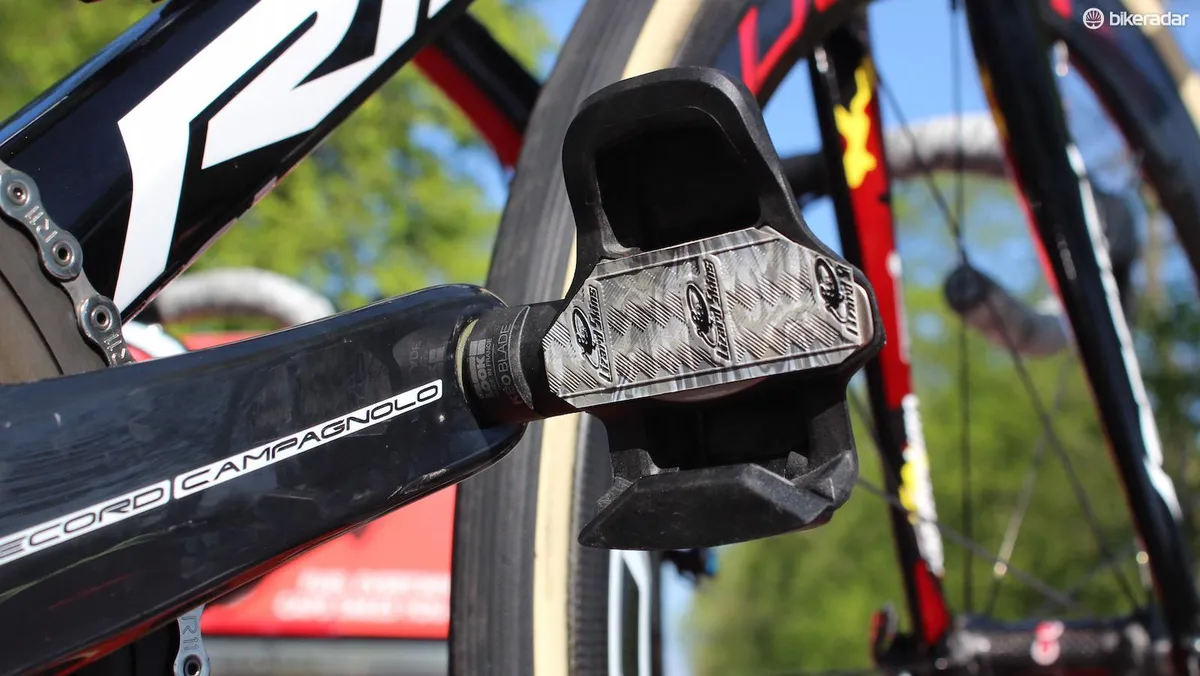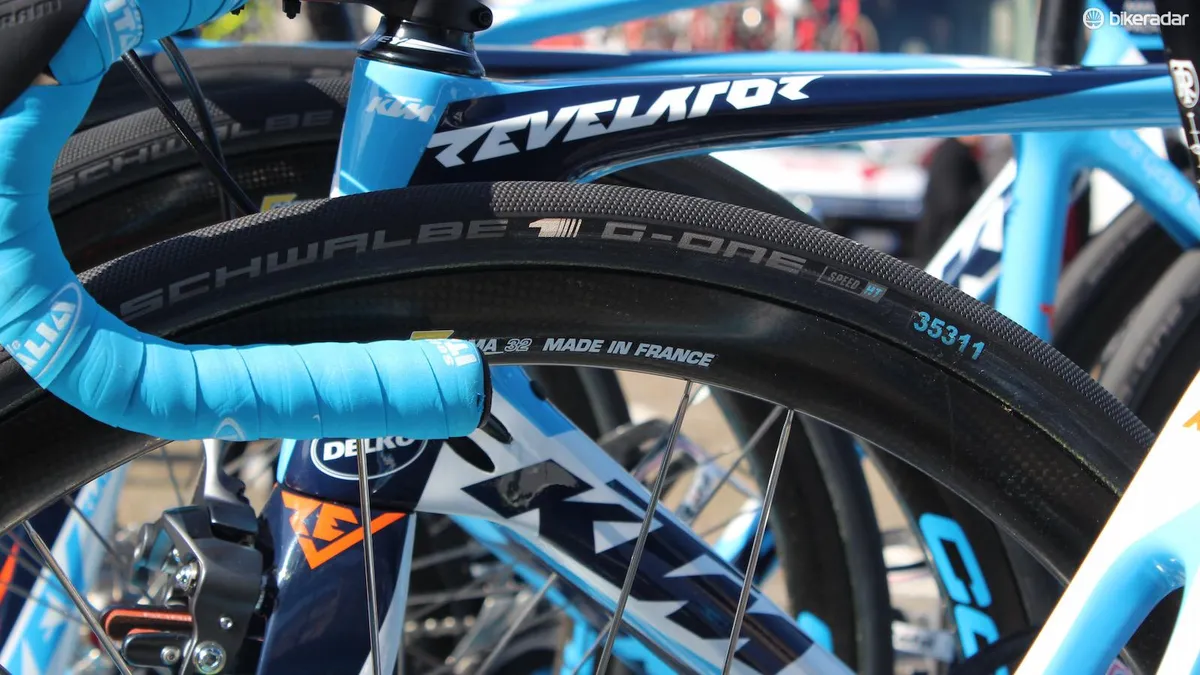With 55km of Paris-Roubaix’s 257km raced over ancient cobblestone paths, the Hell of the North is like no other road race in the world. It follows that the bicycle technology deployed for the day is similarly unique.
- Boonen's goodbye bike: Pro-only front suspension for Paris-Roubaix
- Gallery: two distinct approaches for pre-Roubaix race
This year riders set out on everything from cutting edge projects — such as hydraulic rear suspension automatically controlled by accelerometers and gyroscopes — to the very old school of wide, cotton tubulars run at precisely set air pressures.
BikeRadar visited every team for a closer look at who is using what. The main trends we spotted were suspension, aero bikes, taping seemingly everything, discs for no-hope riders and rim brakes for the contenders. Finally, we investigated what tire pressures and widths various teams were running.
Check out all the details below, and click through the gallery above for all the tech highlights from the 2017 Paris-Roubaix.
Suspension
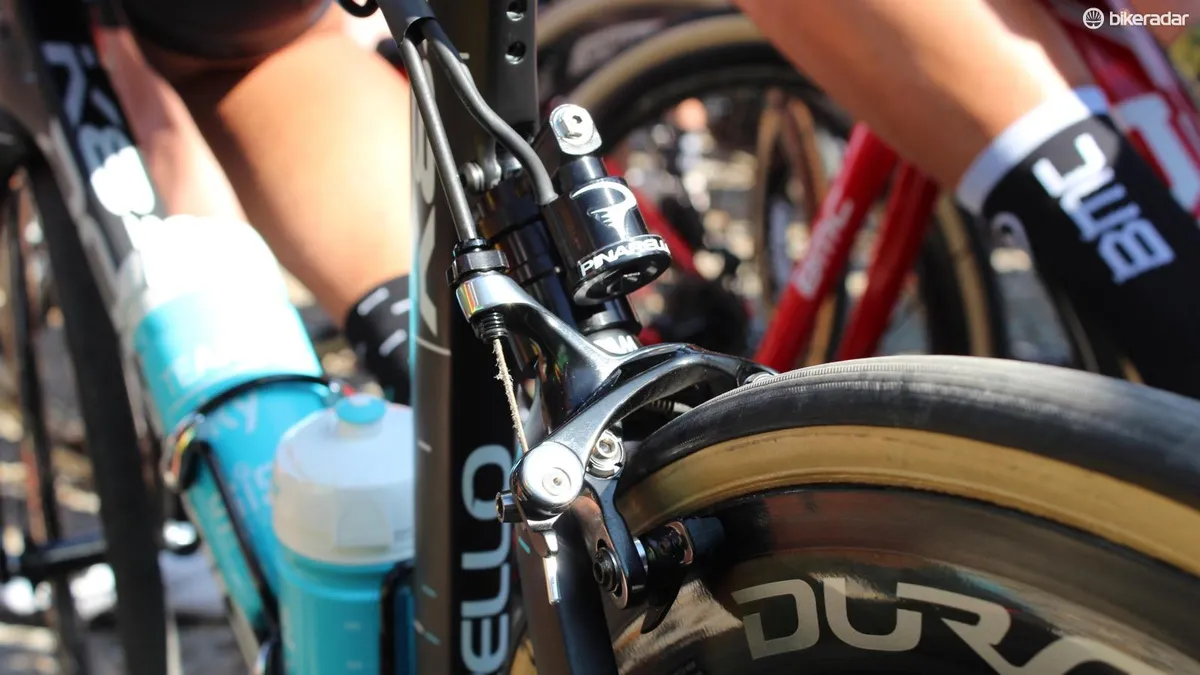
A few other spring races feature cobblestones, notably the Tour of Flanders that precedes Paris-Roubaix by a week. But the Flemish cobbles, which are used as roads for auto traffic throughout the year, are worlds apart from the rough, wildly strewn stones of most of the Roubaix sectors, most of which lie untouched in fields or national forest outside of the event.
BikeRadar first spotted a hydraulic rear suspension shock on Ian Stannard’s Team Sky Pinarello Dogma K8-S at Scheldeprijs. With the elastomer shock on the K8-S has been used since the 2015 Flanders, this hydraulic shock was new — and most surprising was the HiRide internal sensors and remote that controlled the system.
Developed with Pinarello for more than a year, the HiRide system uses 6-axis accelerometers and gyroscope to sense the road surface, and adjust the suspension accordingly. HiRide claims it can open or close the suspension completely in less than a second, letting riders like Stannard sprint on a stiff rear end when on smooth tarmac, but then float with suspension over the cobbles.
Stannard and Team Sky teammate Gianni Moscon started the race with the HiRide hydraulic units. The handle-bar mounted remote can be used to manually override the automatic control system.
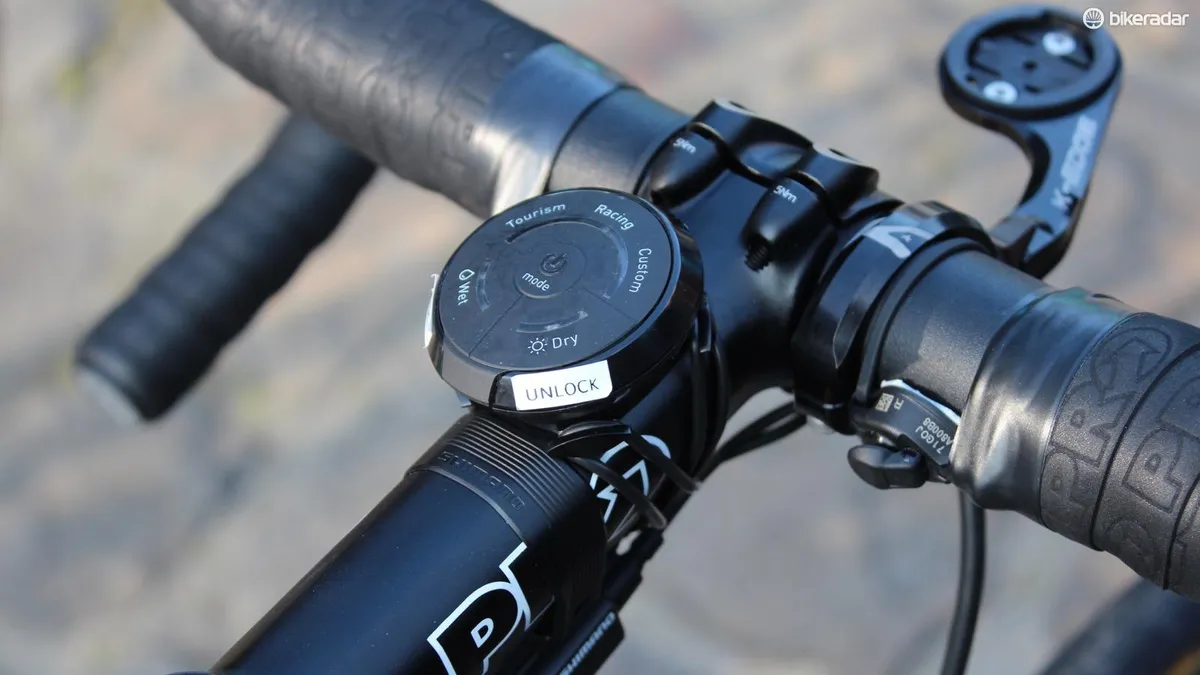
Specialized’s new Roubaix also goes for suspension, but at the front end with the spring-cartridge Future Shock that sits underneath the stem.
World champion Peter Sagan’s entire Bora team is racing on the new bikes, which for the pros use rim brakes and long-and-low geometry instead of disc brakes and a more upright geometry built into the consumer Roubaix models.
Four-time Roubaix winner Tom Boonen is also racing on a new Roubaix. All his wins came on previous editions of the Specialized Roubaix. He is retiring after Sunday’s race, and Specialized and seemingly all of Belgium was clearly hoping for one more win for big Boonen.
The Future Shock has 20mm of travel, and normally comes with three different spring weights. For the pros, Specialized developed a stiffer spring with progressive compression on both ends of the stroke, much like a parabola.
The stock Roubaix comes with a CG-R seatpost, that flexes twice as much as a normal carbon post, but none of the pros are using it.
Trek’s Domane SLR features pivots at the front and rear of the bike, which allows the frame to splay a bit to absorb hits. Using direct-mount calipers, the Domane SLR can also easily handle 30mm tubulars.
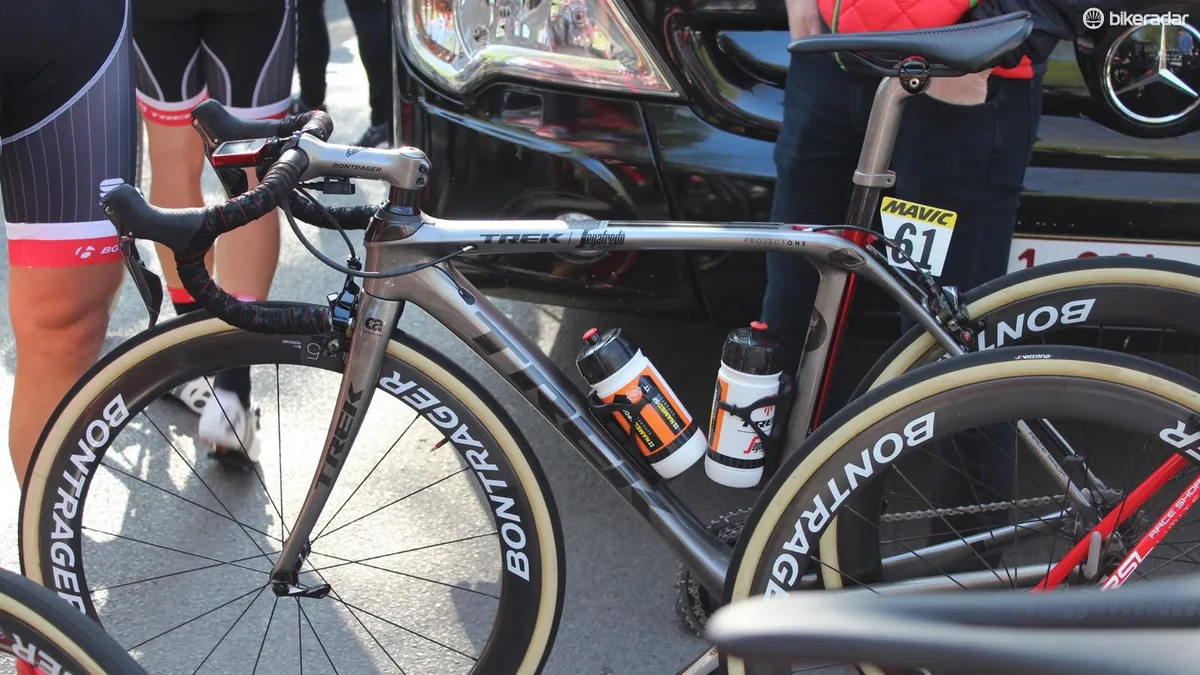
The Domane SLR features adjustable suspension in the back end, with a slide along the seat tube effectively shortening or lengthening the amount of tube that flexes.
Aero bikes
On the other end of the spectrum from endurance bikes with integrated suspension, more than a handful of aero bikes were on display in the cobbled square of Compiegne, where Paris-Roubaix starts. There seemed to be two strategies for employing aero bikes: either take them start to finish, or use them for the first paved half of the race before switching to another machine for the cobbles like Sagan did last year.
Three marquee riders stood at the front of the peloton before the race start, and two were on aero bikes. As Boonen mugged for the cameras from the saddle of his Roubaix, Orica-Scott’s Mathew Hayman sat astride his Scott Foil, which became the first aero bike to win Paris-Roubaix with his unexpected win last year. For 2017, Hayman rode a Foil RC with custom cobbled-Kangaroo graphics.
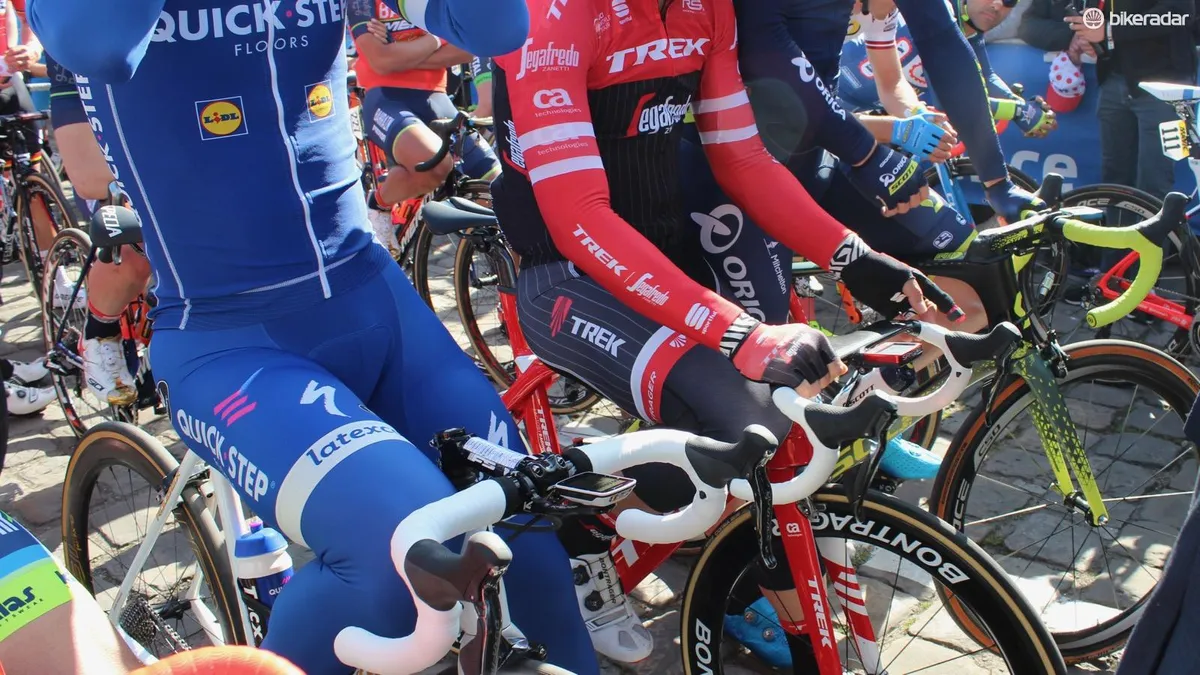
In between Hayman and Boonen sat 2015 winner John Degenkolb on Trek’s aero bike, the Madone. Degenkolb had a Domane SLR at the Trek-Segafredo bus set up with all the other race bikes. He had his race number bolted to the Domane SLR, which he rode to the start. Then a mechanic rode the Madone over to meet Degenkolb at the start, where he switched before making his way to the front of the line.
Riders from other teams also took the line on aero bikes, such as Movistar and Katusha on Canyon Aeroads.
Taped wrists and fingers, stems, bars and top tubes
While new technology abounded at Paris-Roubaix this year, riders and teams still used the tried and true simple solutions as well. Tape, for instance, was to be found on many riders and their bikes.
To contend with the violent vibrations from riding across the cobbles, dozens of riders taped their wrists, and a few taped their finger joints as well.
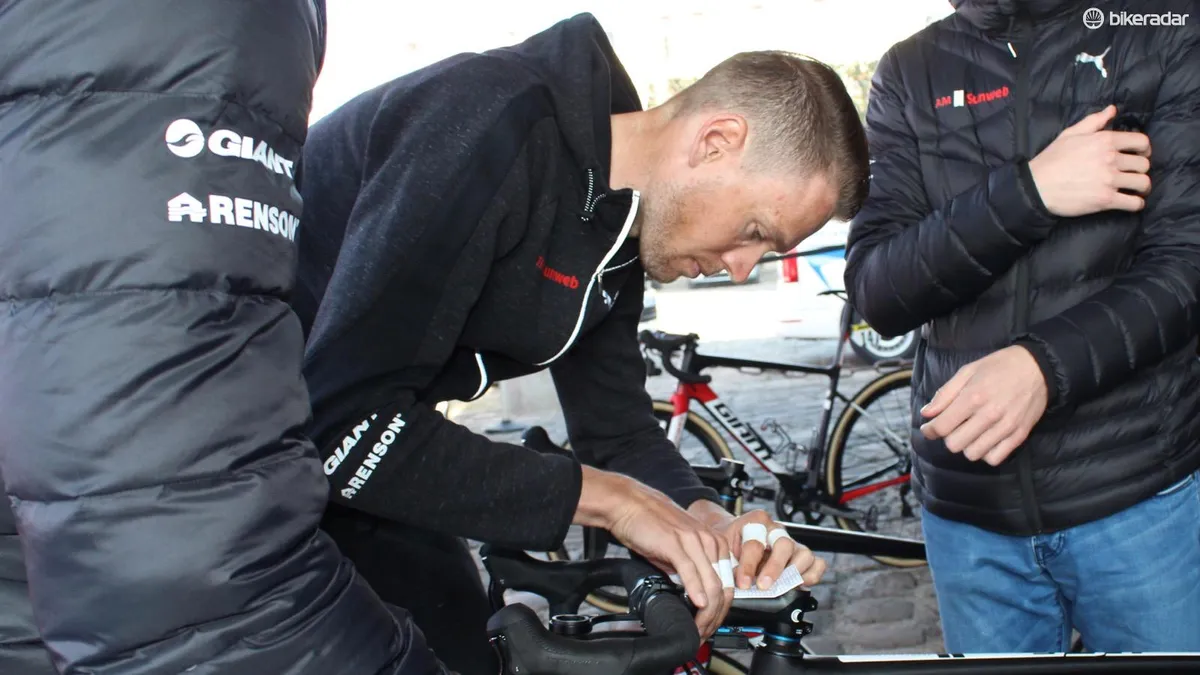
To keep computers and GoPros attached, electrical tape was deployed across the teams.
Course-detail stickers are nothing new in the peloton, ranging from the hand-drawn on tape to the carefully designed and printed stickers. The most interesting this year was the dual-layer strategy used by Dimension Data. After completing about half the cobble sectors, riders could peel off the top layer to see the second half of the race on their stems.
Dimension Data’s director sportif Roger Hammond said he drew inspiration for the peel-off stickers from moto racers, who maintain clear vision with a series of peel-off stickers on their goggles.
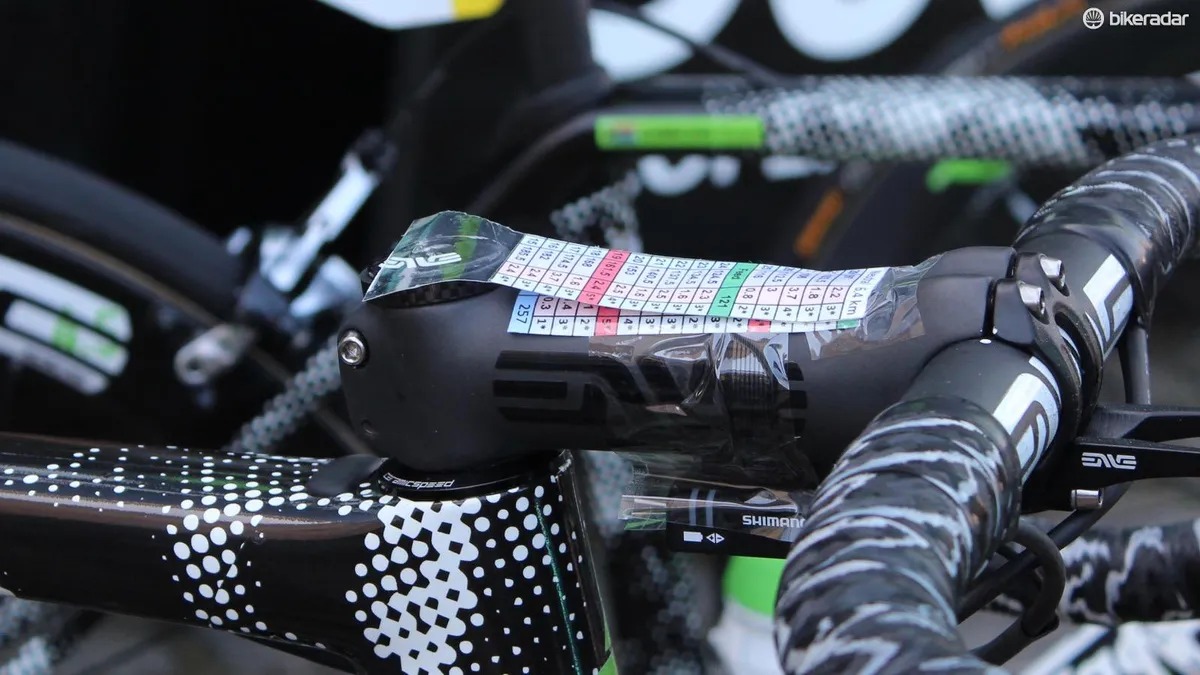
“For long races, you can run a long sticker down the top tube, but for Roubaix you can’t be looking down between your legs like that,” Hammond said.
While some riders on other teams opted to just write down a few key sectors on a piece of tape, Hammond said giving the riders full details allows them to communicate better with the team should they puncture.
“We have measured it, and sometimes our closest team car can be up to 12km behind a rider with a puncture,” Hammond said. “And then riders have to work out where they are on course to help us get to them quickly.”
More electronic remotes, fewer bar-top brake levers
Years ago, ‘cheater’ brake levers mounted on the handlebar top were a fairly common sight. Some riders used one; others used a pair. Like double-wrapped tape, those have decreased in number recently, although race winner Greg Van Avermaet and 2015 winner Degenkolb used each used one this year.
Now you are much more likely to see digital remote controls on the bars than little brake levers. Most teams are on Shimano, and riders use a mix of climber switches — which were designed to be mounted up high and operated with the thumb — and sprint shifters, which can be stuck anywhere a rider likes.
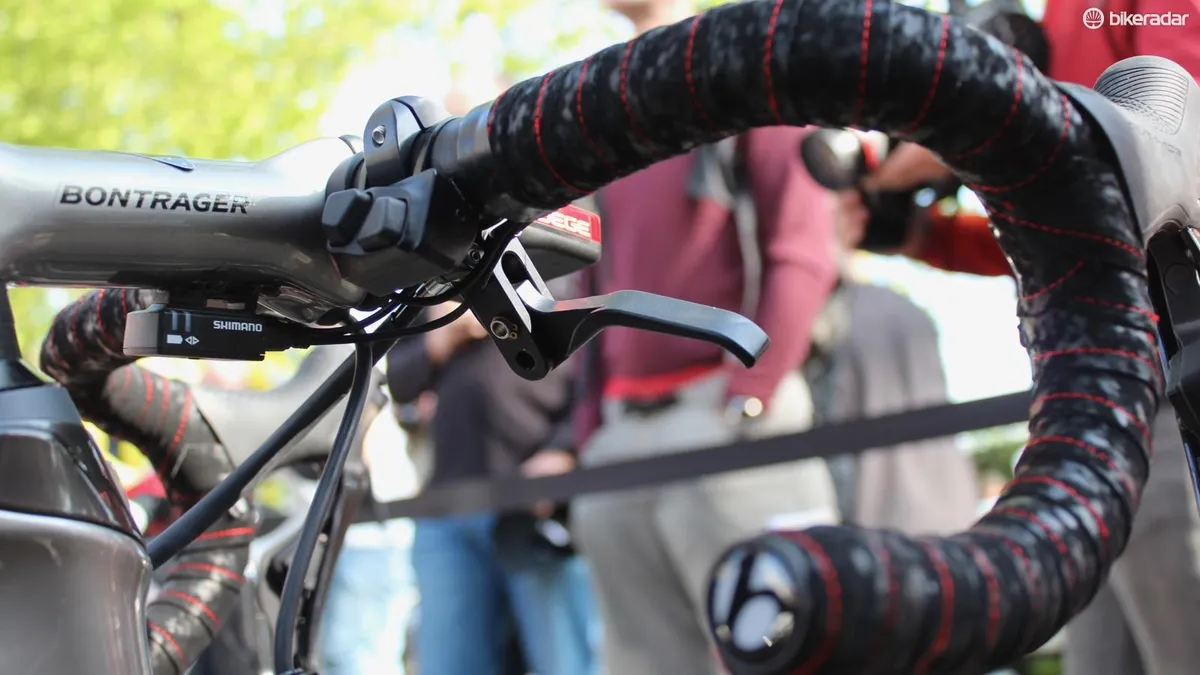
The names of the Di2 satellite shifters clearly no longer strictly apply to how riders use them; the climbing switch is appreciated on the dead-flat Roubaix course because much of the cobbles riding is done with the hands atop the bars. And while many sprinters do use the sprint shifters for changing gears with the thumbs while in the drops, plenty of other riders position the tiny levers right next to the stem.
The Di2 buttons can be programmed to change either derailleur, but most riders use them for the rear. The climbing switch has up/down buttons on the same unit. The sprint shifters are single-button, single-direction controls.
SRAM’s eTap system has ‘Blip’ remotes that function like the sprint shifters. They are harder to accidentally shift than the sprint shifters, where a simple nudge from the side can activate them. The Blips are more like elevator buttons; you need to depress the button inside of the cylinder straight down to active it.
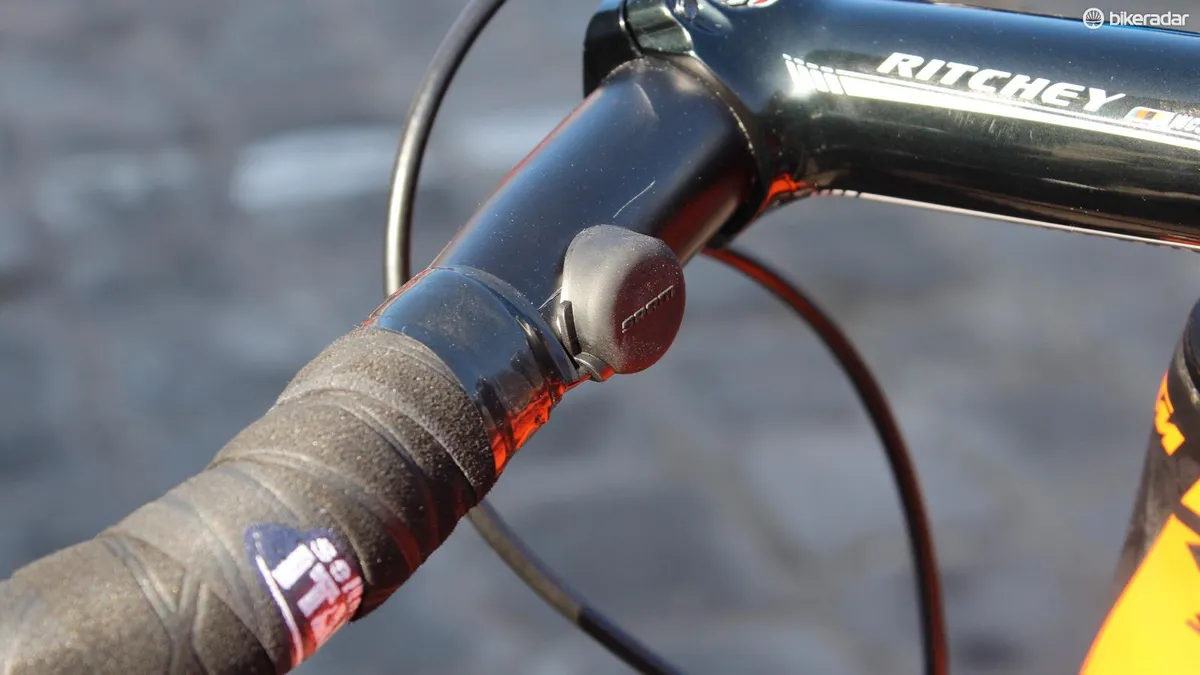
And of course, the really new remote this year was the HiRide control of the Pinarello Dogma K8-S hydraulic suspension.
Bottle security
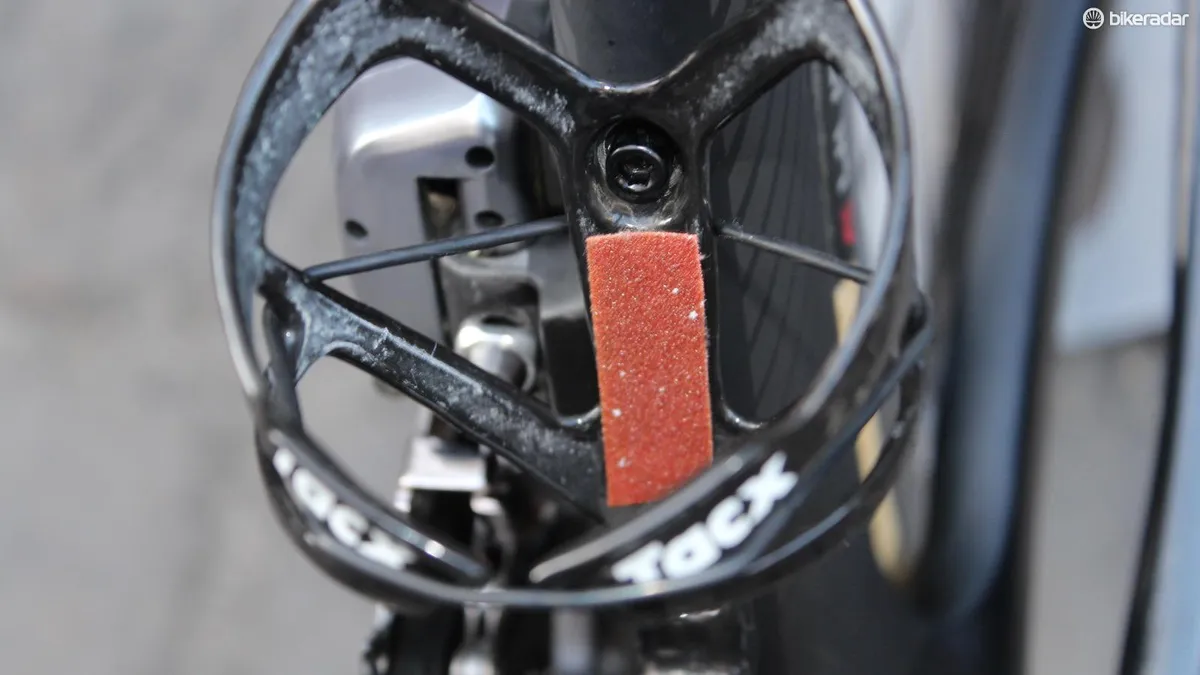
Water bottles aren’t high tech, nor are bottle cages. But keeping said bottles in said cages over the cobbles always proves a challenge.
Grip tape inside the bottle cages is a fairly common trick. And this year we saw a few teams using tubular rubber bands around each cage as well.
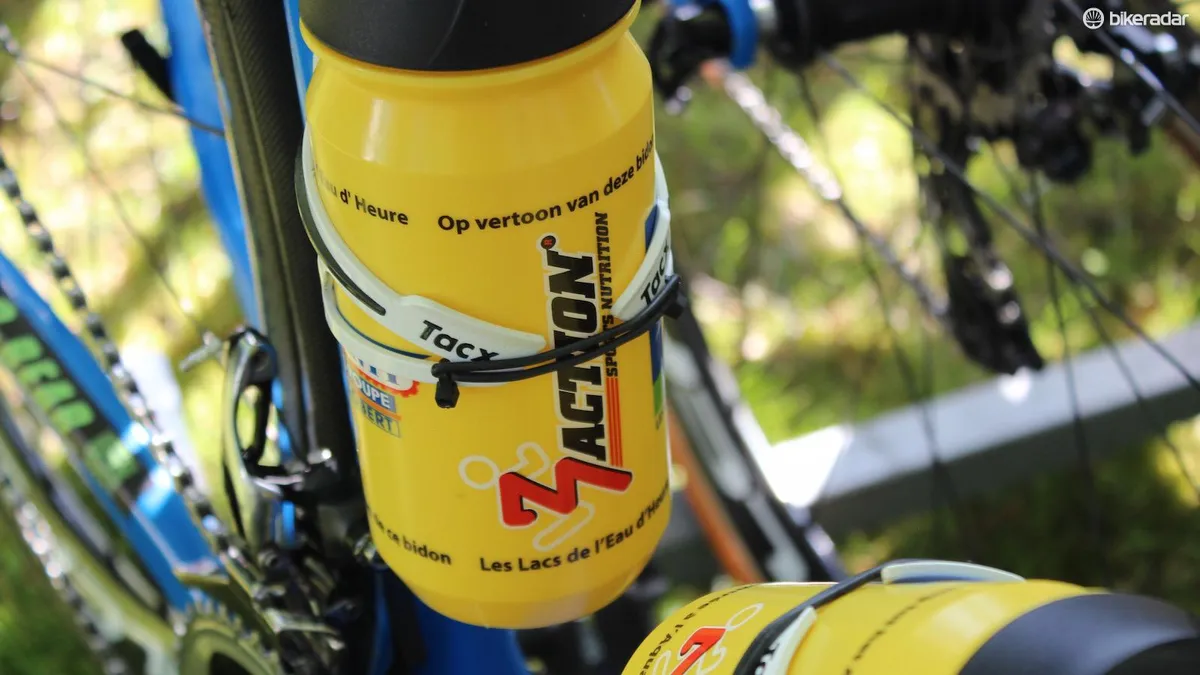
No-hopers on discs
While a number of teams had riders on disc brakes, none of the overall contenders used the technology. The reason isn’t a matter of preference for one braking system or another; it simply comes down to teams wanting to have as many options as possible for wheel changes should a top rider flat.
In addition to neutral support and team cars in the race caravan, teams station mechanics and even friends of the team along the course with spare wheels. While thru-axles and disc brakes provide better braking performance, the riders going for the win at Paris-Roubaix are trying to do everything as fast as they can — including wheel changes.
Cable discs — and maybe a new Cannondale Synapse?
One interesting thing to see was the number of riders on cable-actuated (instead of hydraulic) discs, including a single plain-green Cannondale. While all the rest of Cannondale-Drapac was on current Synapse endurance bikes with rim brakes, William Clarke had an unmarked machine with Di2 shifting and cable discs.
The bike had the Synapse split seat tube near the bottom bracket, and a quite-tall head tube. Cannondale-Drapac staff asked us not to take (more) pictures of the bike, and wouldn’t say what it was.
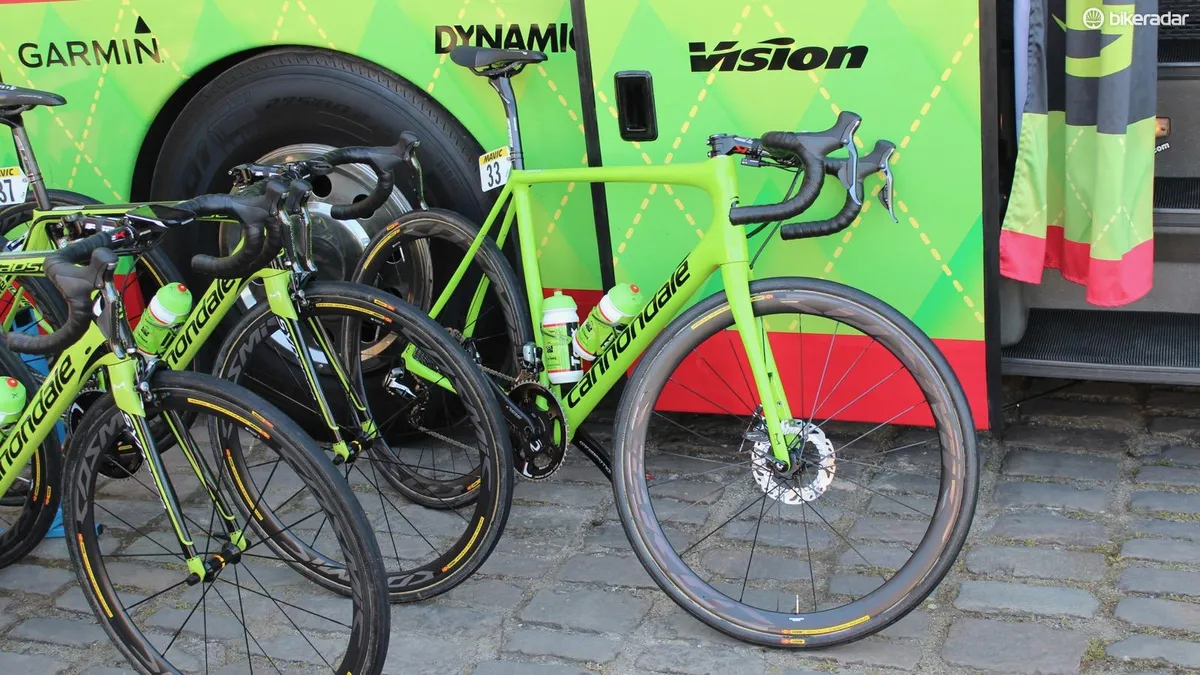
As for the mechanical discs, Cannondale mechanic Geoff Brown said the team didn’t yet have full access to Shimano’s new Dura-Ace hydraulic discs and levers, and riders didn’t want to go into big races on new equipment.
“All riders like to train with standard Dura-Ace levers, and they are new to discs. For a race like Paris-Roubaix, they want to be very familiar and comfortable with the gear. But this is just a one-off thing; we will change over soon,” he said.
As a result, any rider on disc brakes was not a rider expected to see the podium in Roubaix.
Tire widths and pressures
In the toughest one-day race on the calendar, it all comes down to where the rubber meets the road — a road built of both smooth tarmac and age-old stones.
The last two years many teams went from 28mm to 30mm tires. Degenkolb won on 30mm in 2015. This year tubulars ranged in width from 27mm to 30mm, mostly from Continental, Vittoria, Dugast and Specialized. Most riders seemed to choose 28mm.
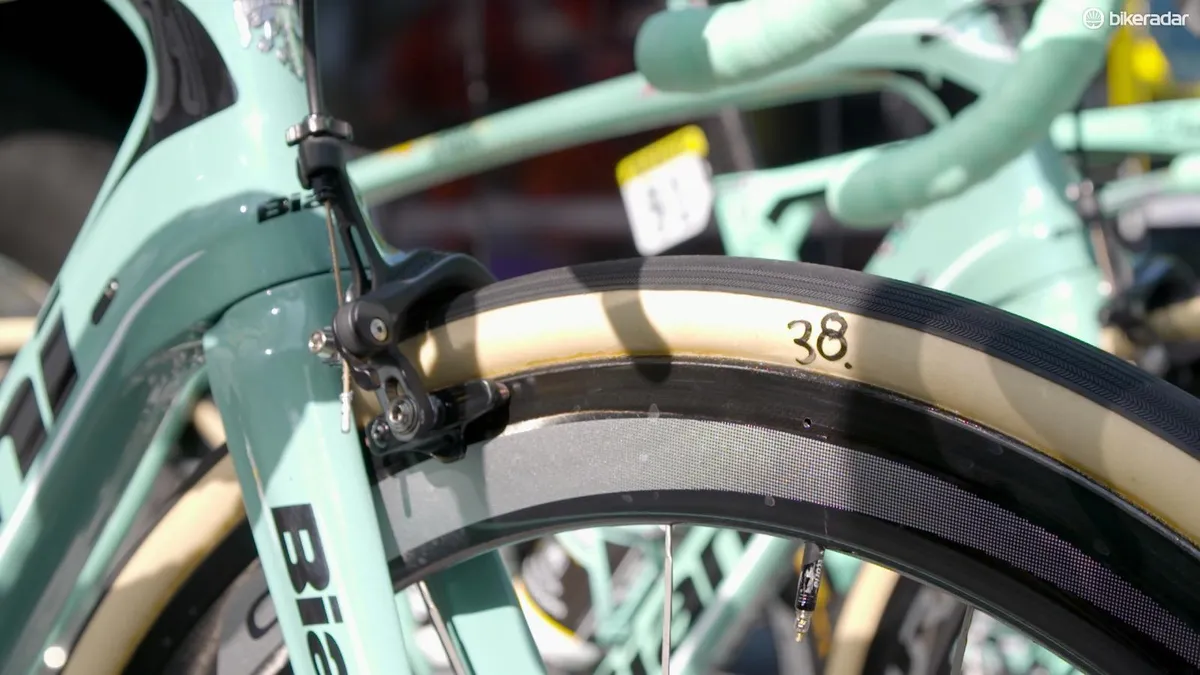
Tire pressures ranged from 3.8 to 6 bar, or 55-87psi. Most riders were in the 4-5.5 bar / 58-80psi range. As always, the specific pressures varied depending on riders weight and preference.
“We have been testing a lot, as I’m sure the other teams have,” said Team Sky mechanic Thomas Kousgaard. “Sure, you can use a bigger tire and run it very soft, but at the end of the day, they also have to race 200km where they have to travel fast.”
At Dimension Data, Roger Hammond said that tire width and pressure was like anything else on the bike — “it’s always a compromise.”
“You can have a big balloon of a tire that is a super soft, but then you have a heavier tire that rolls slower. It’s the same for everything – it’s always a compromise. For tires, it’s rolling resistance, comfort and weight. Once you do the mathematics, it’s not just about comfort.”
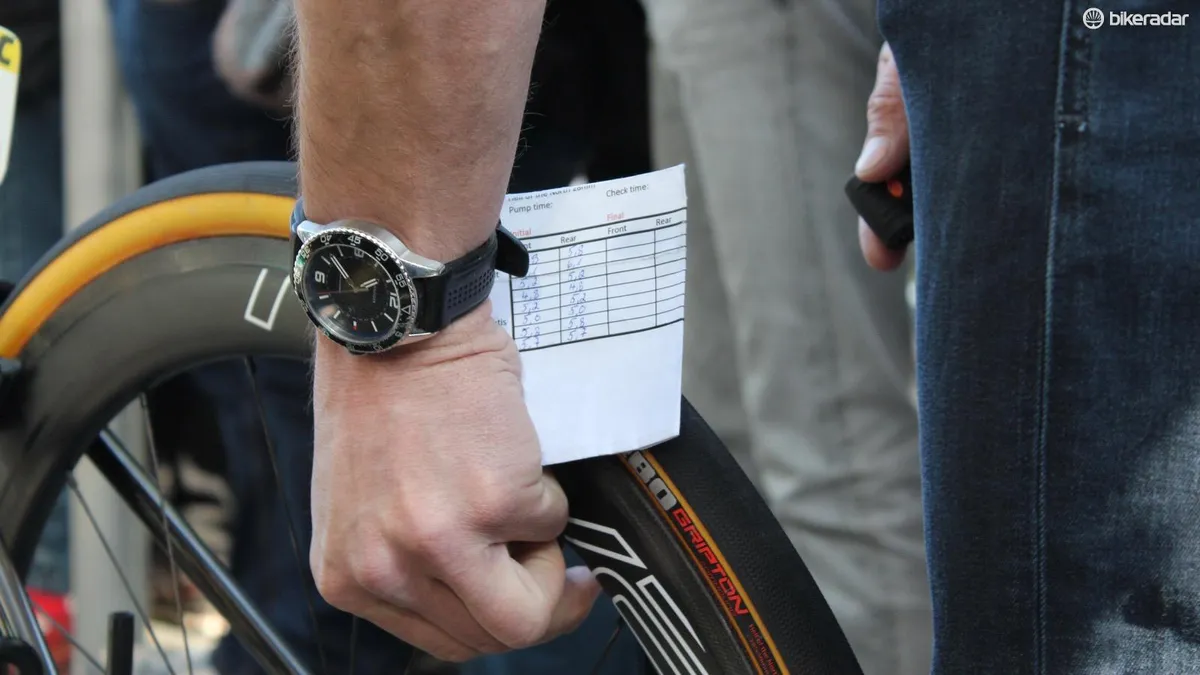
Dimension Data settled on 28mm tubulars mounted on ENVE SES 4.5 AR wheels — the Utah brand’s ultra-wide aero set built for fat tires — with pressures in the 4-6 bar range.
Trek-Segafredo technical director Matt Shriver said Degenkolb has his tires set to 4.5 front and 5 bar rear.
“You lose about 0.6 bar over the course of the six-hour race,” Shriver said. “Of course, it would be nice to come into the velodrome empty, but it is too much of a danger to start too low.”
Click through the massive gallery above for an inside look at the machines of the 2017 Paris-Roubaix.
